
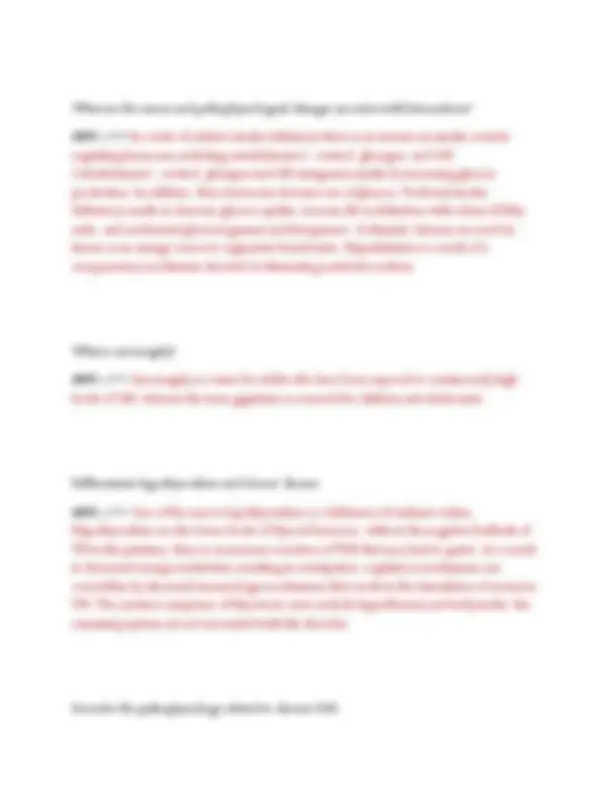
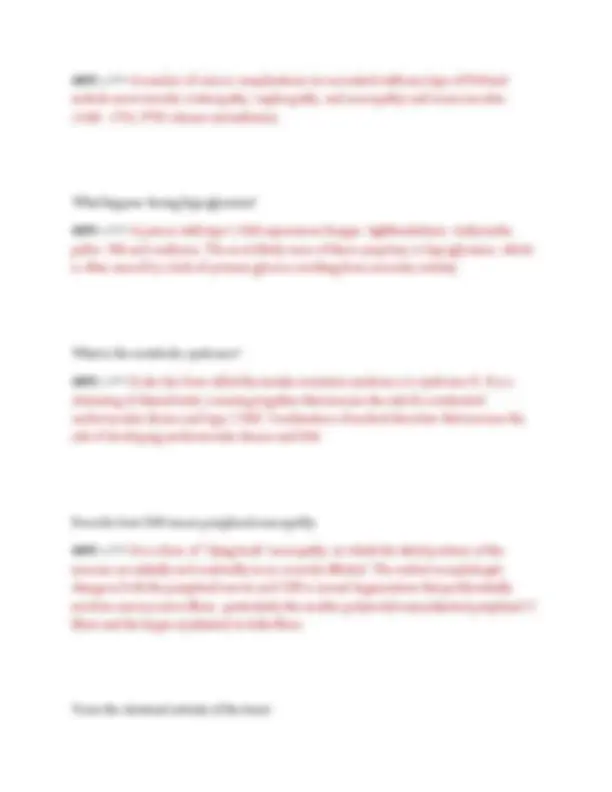

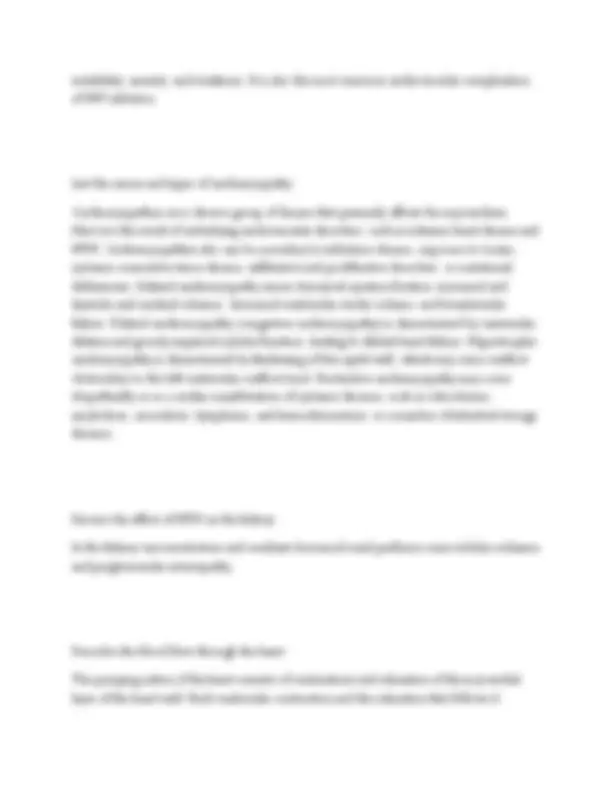
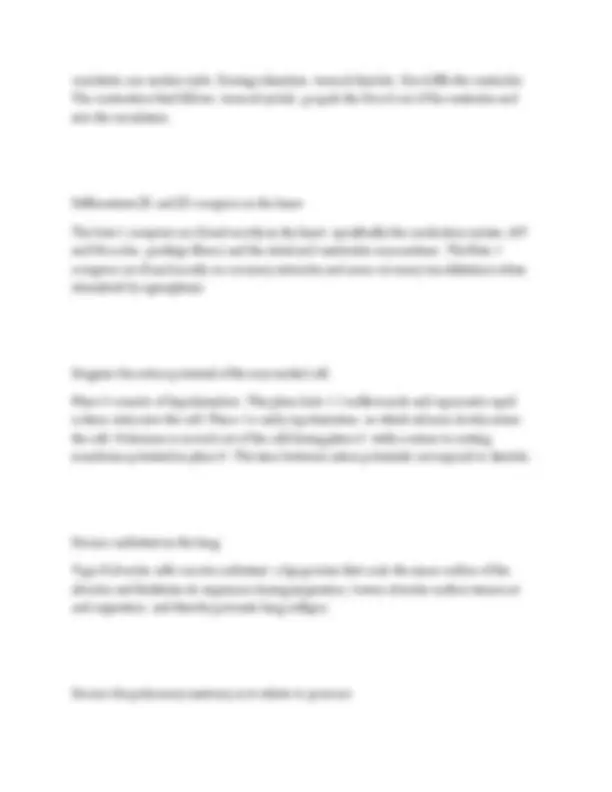
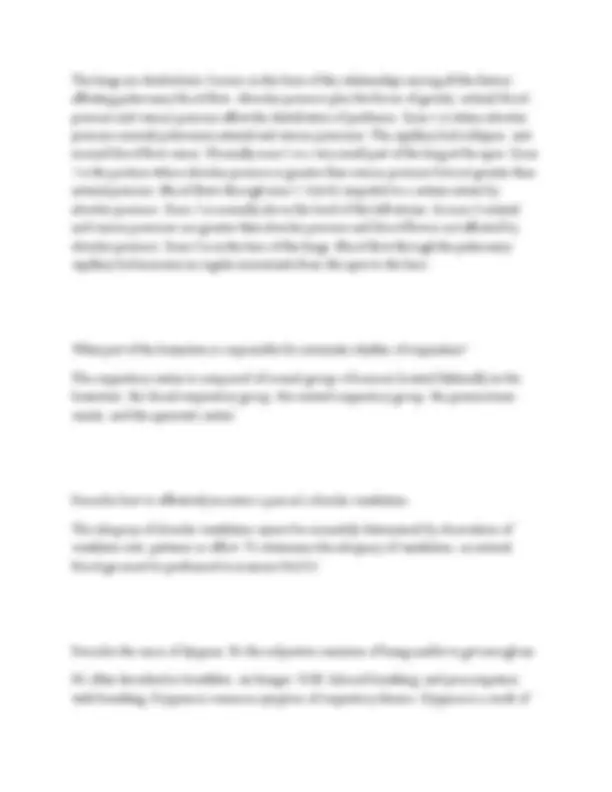
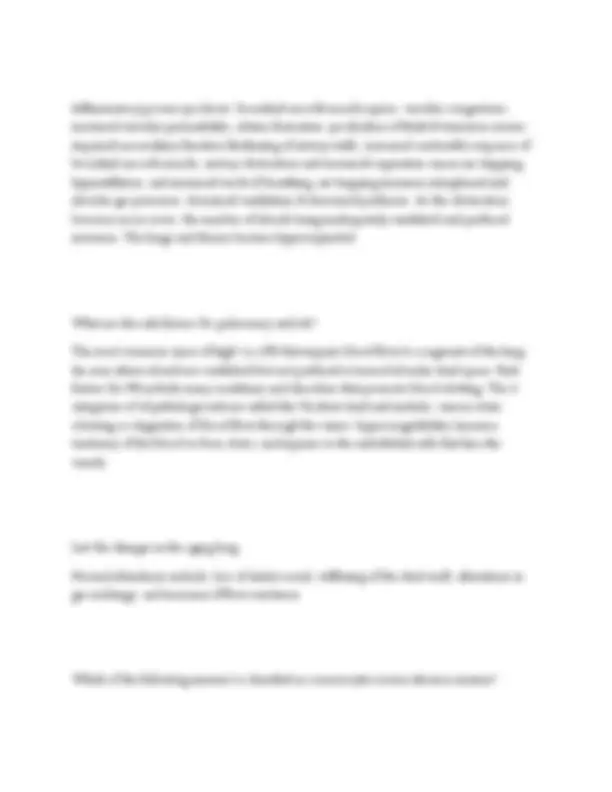
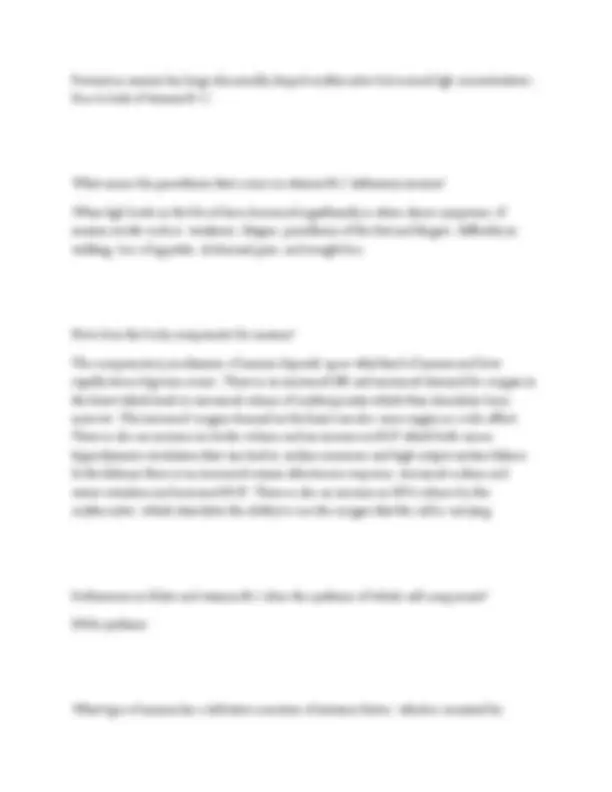

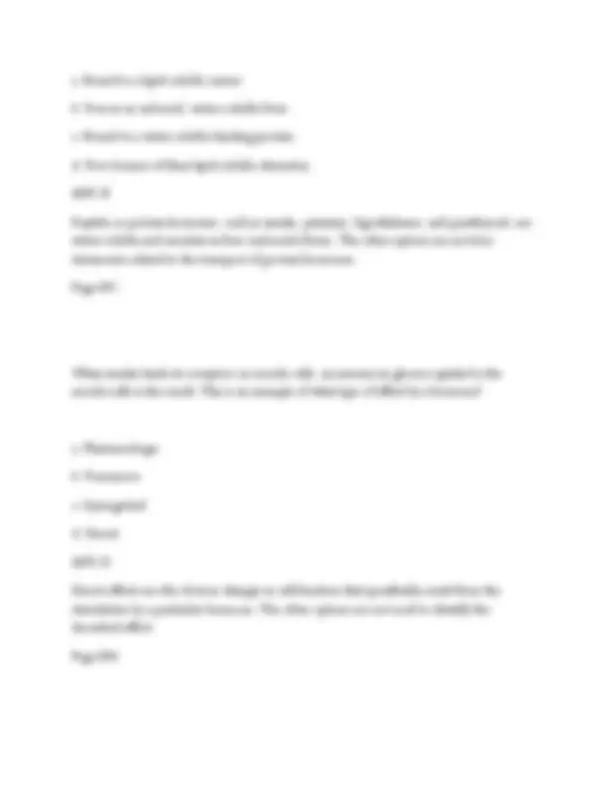
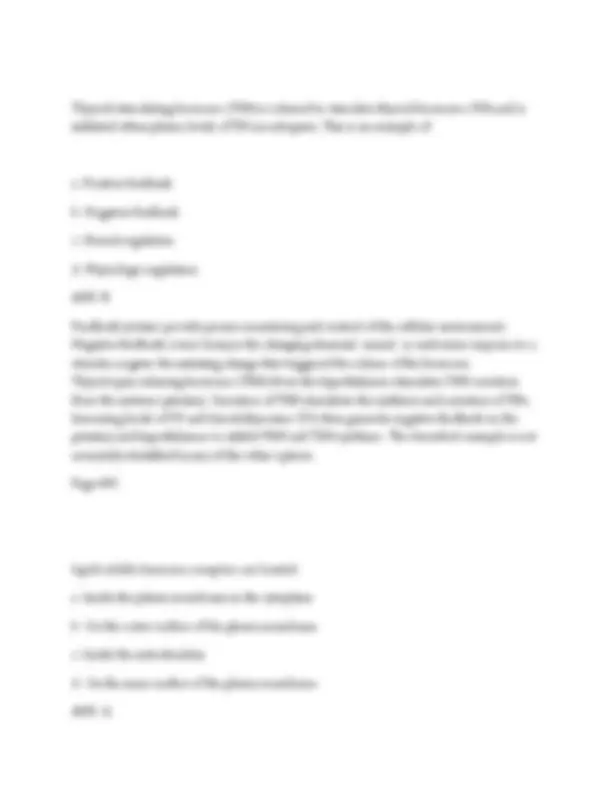
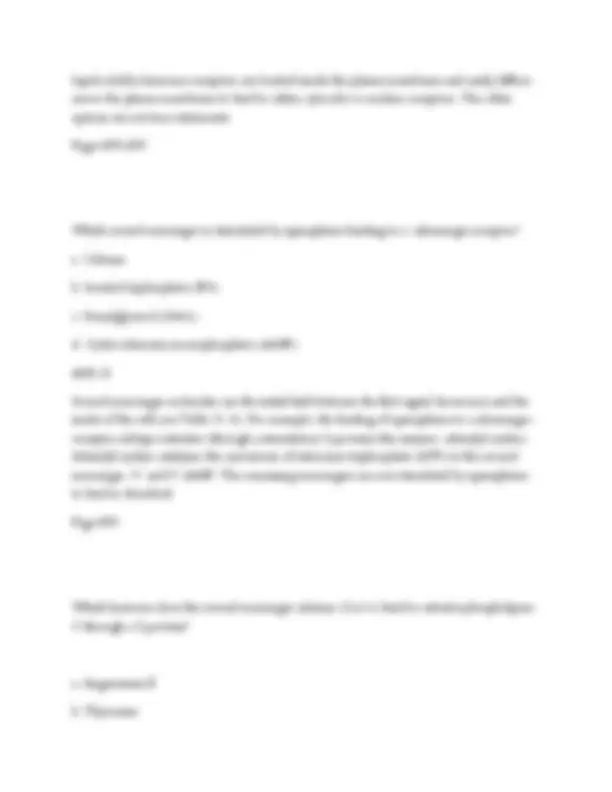
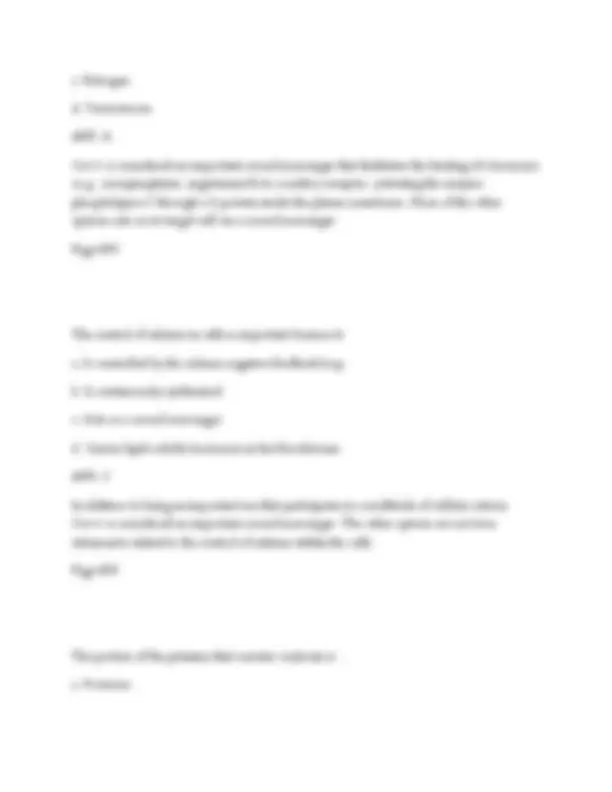

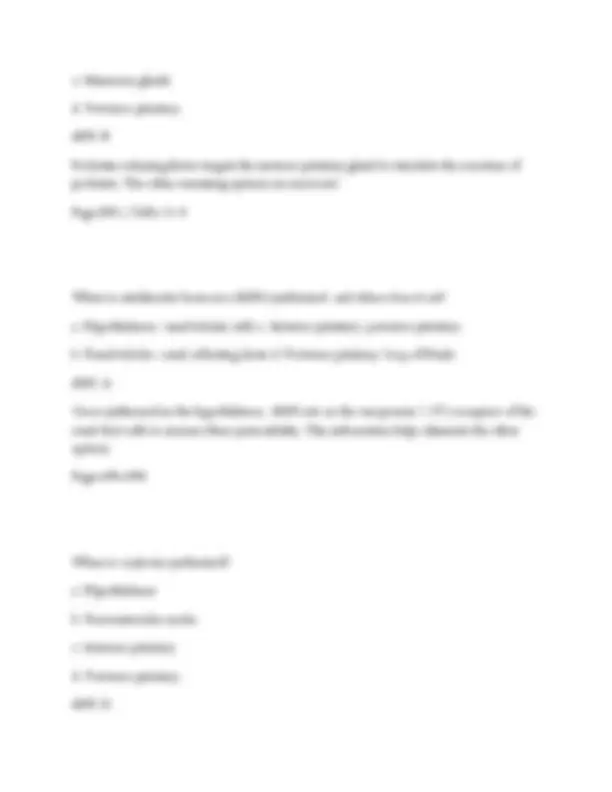
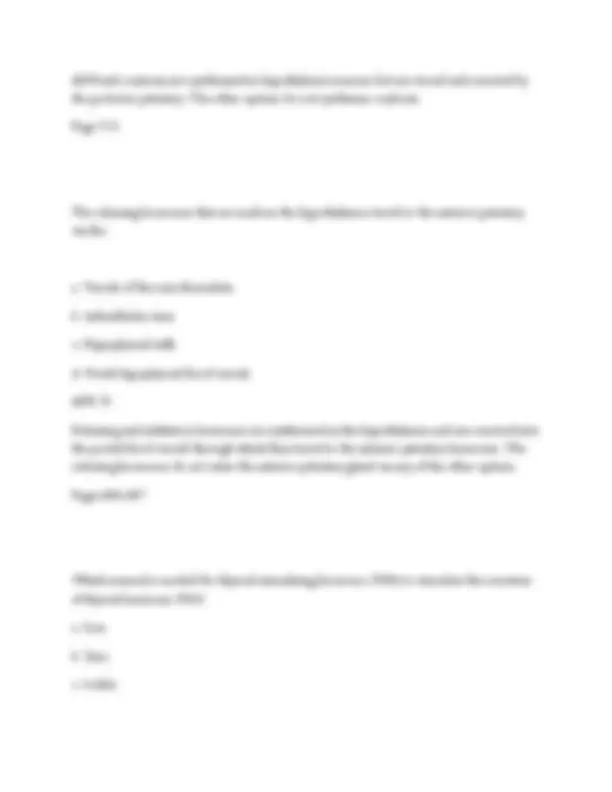
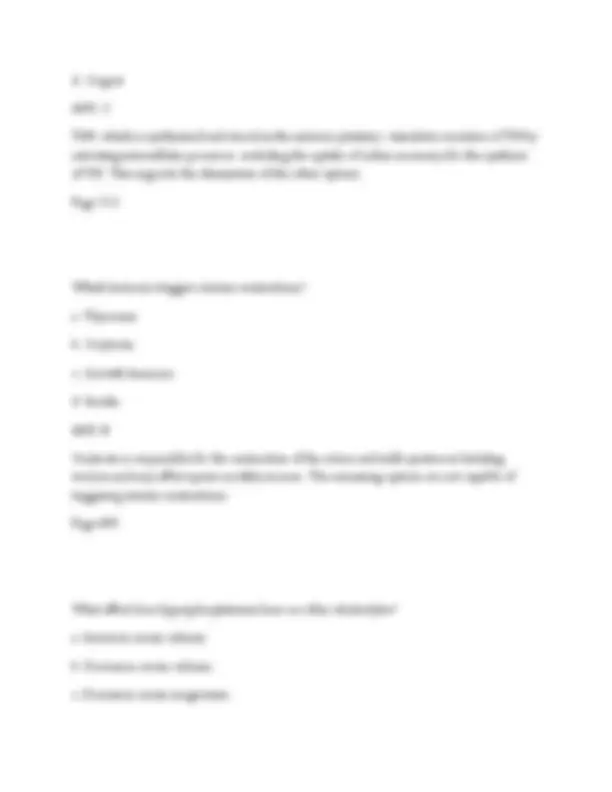
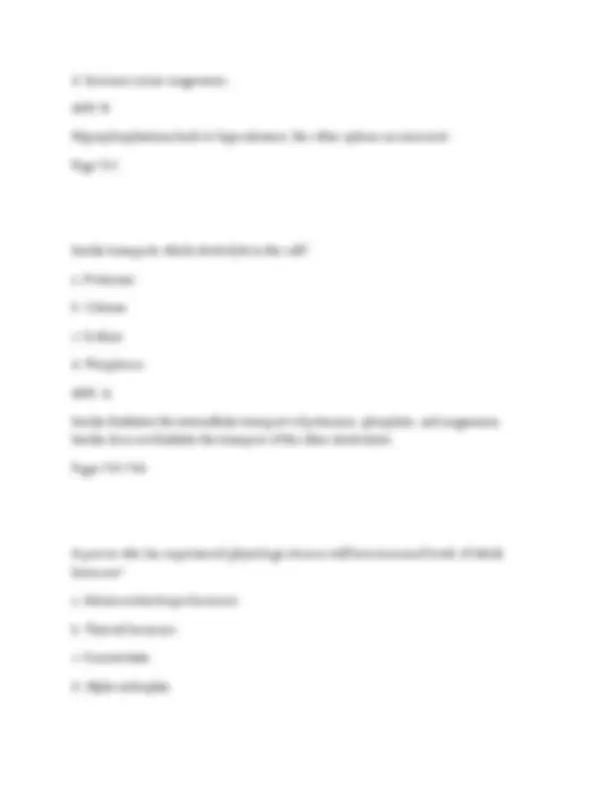
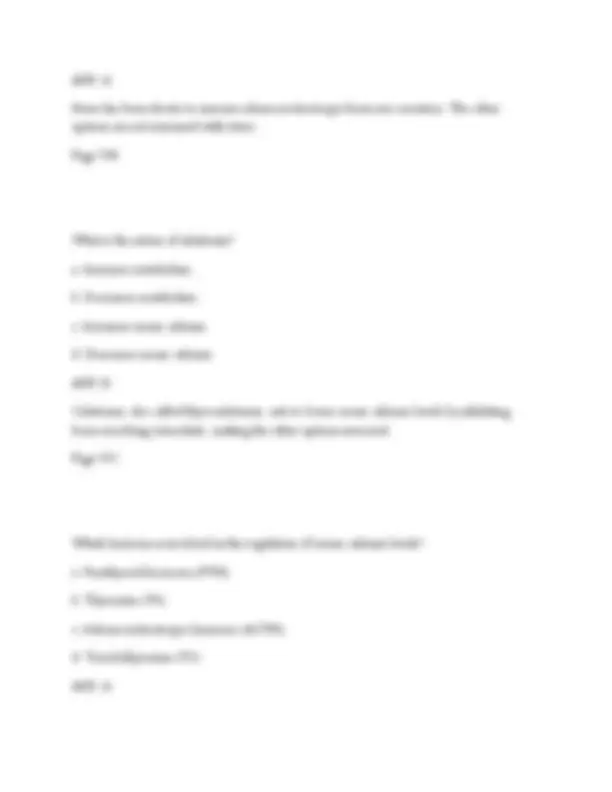
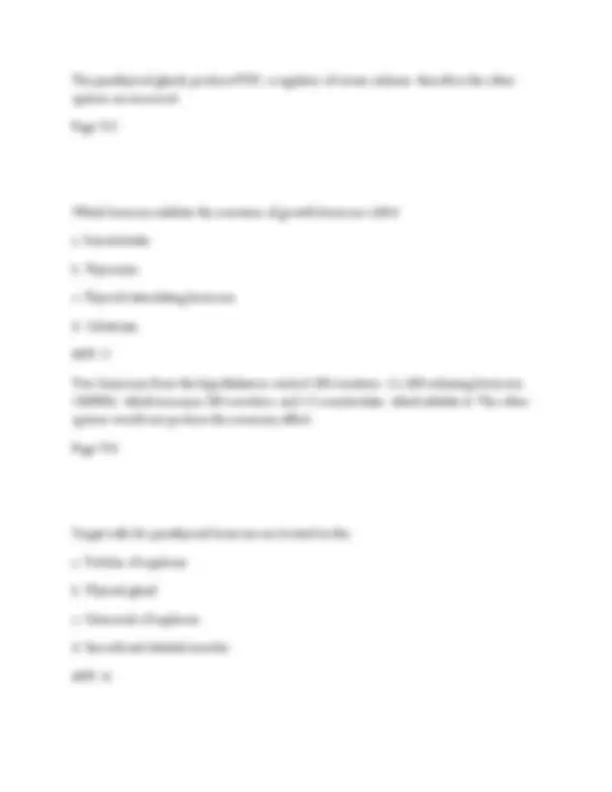
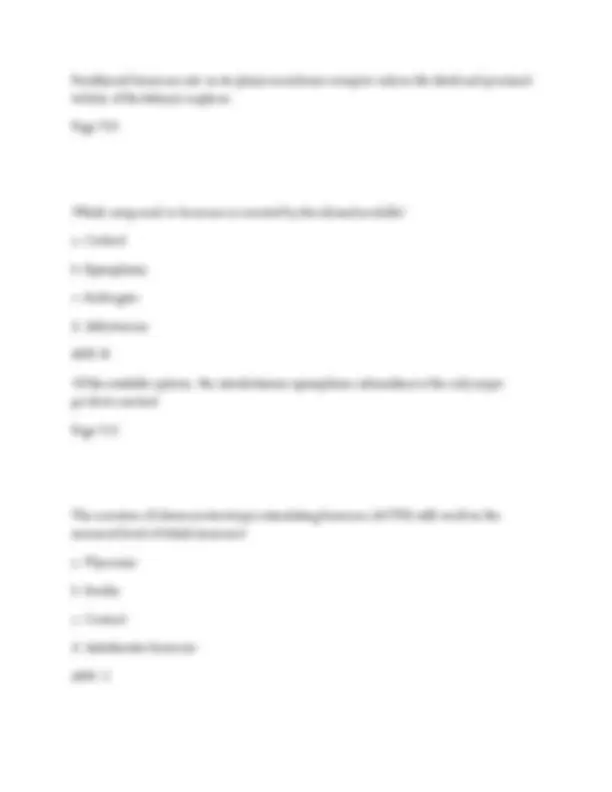
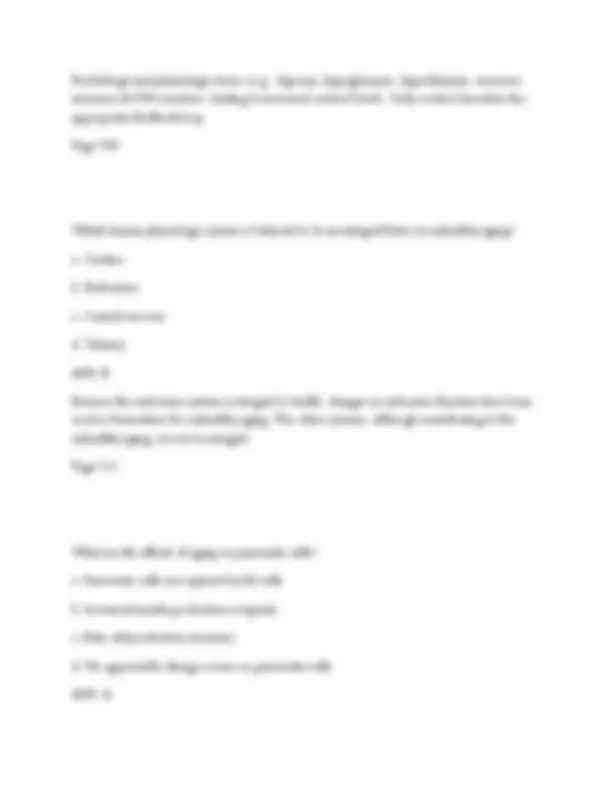
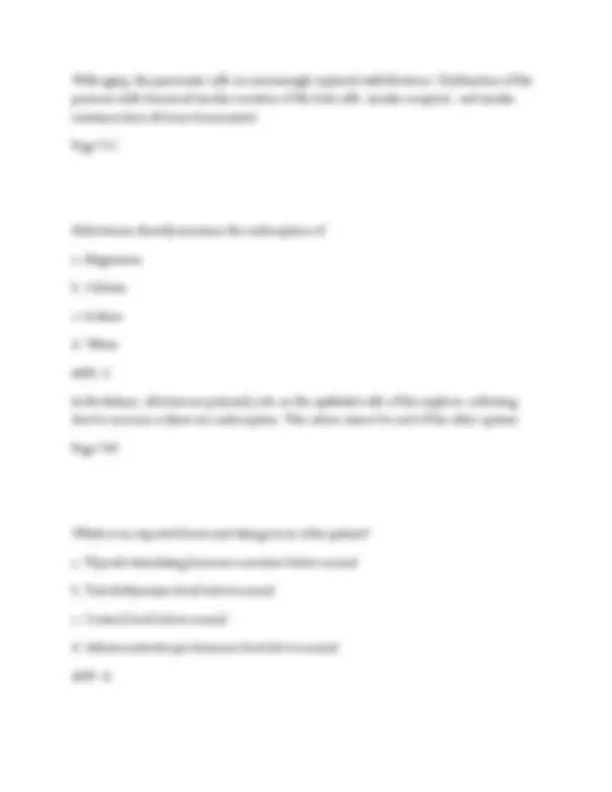
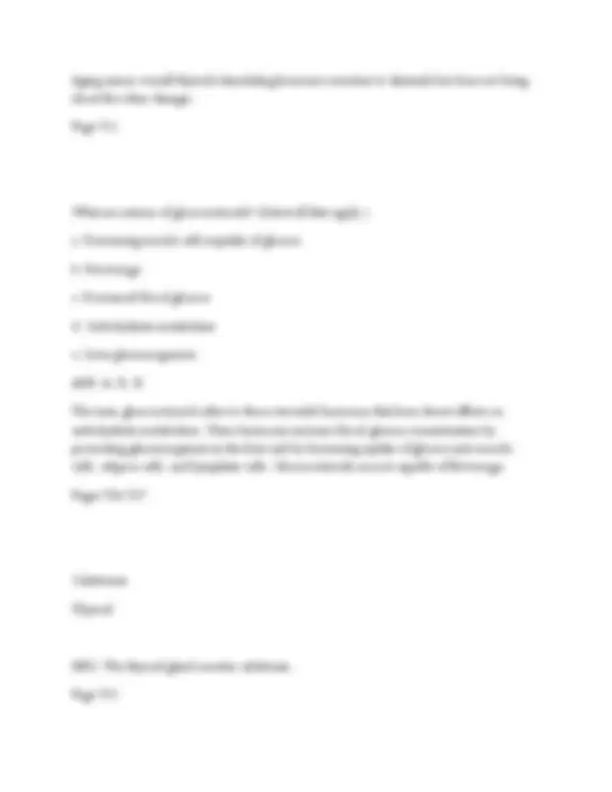
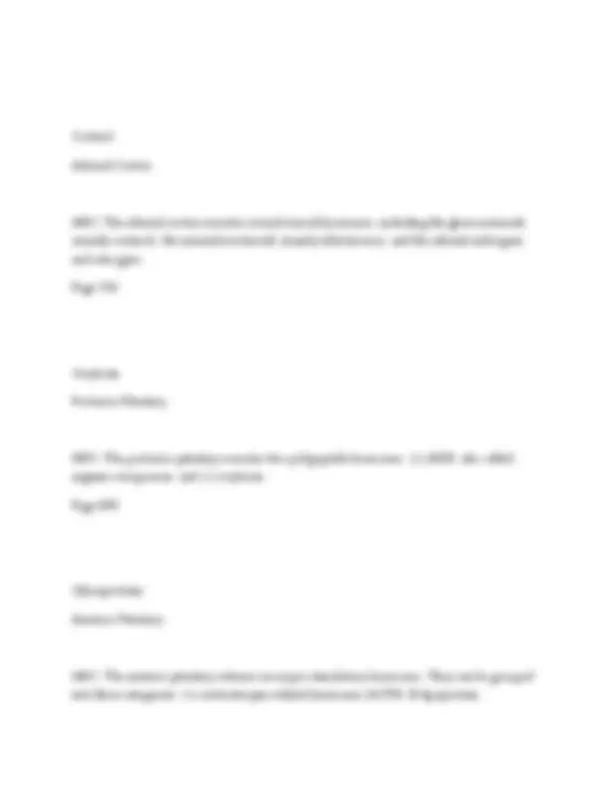
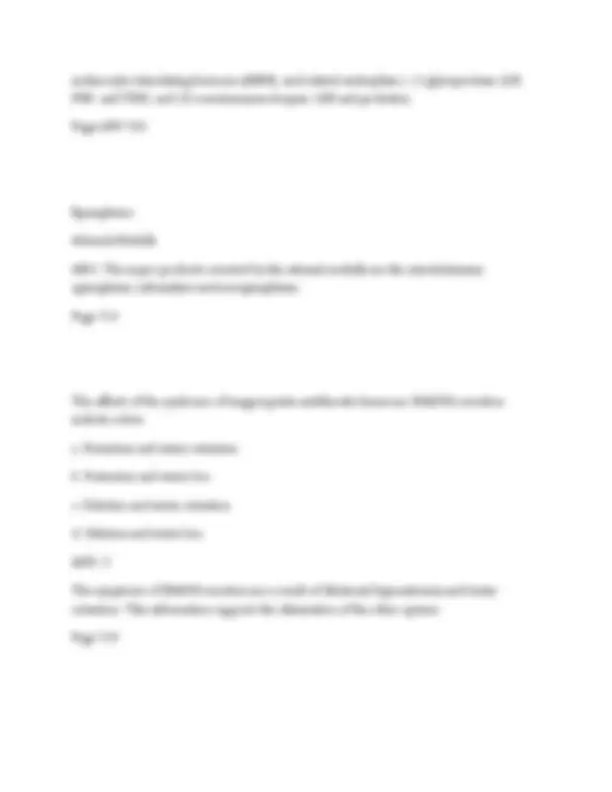
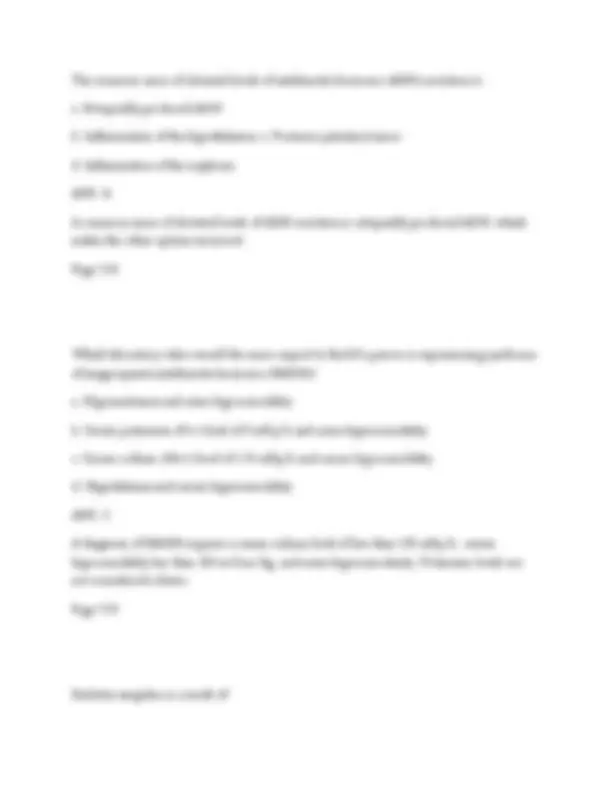
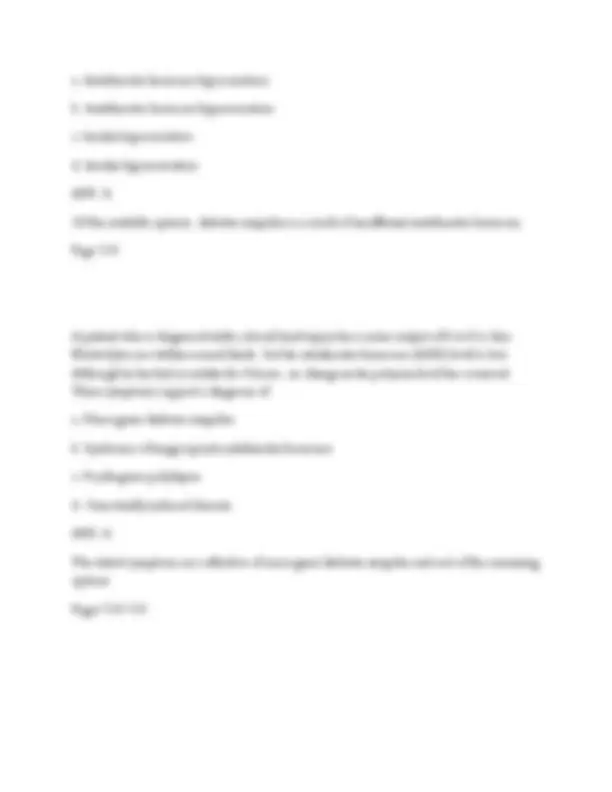
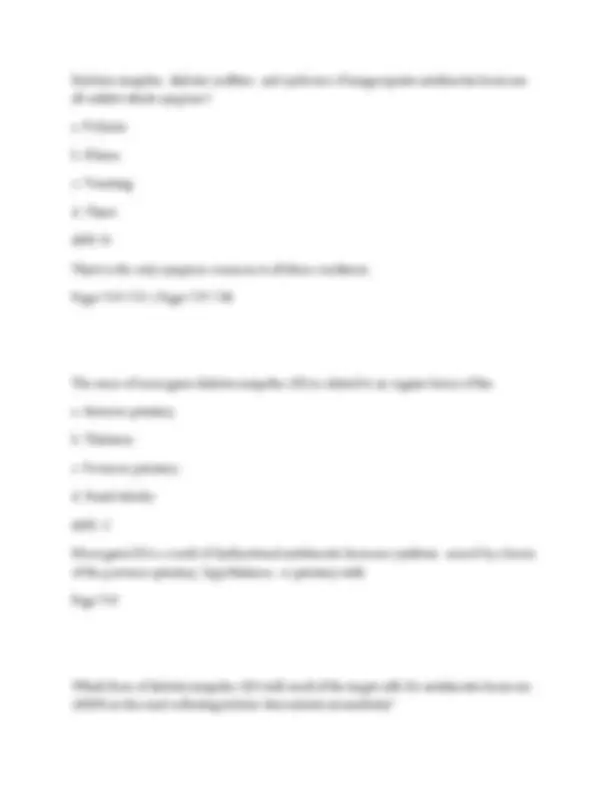
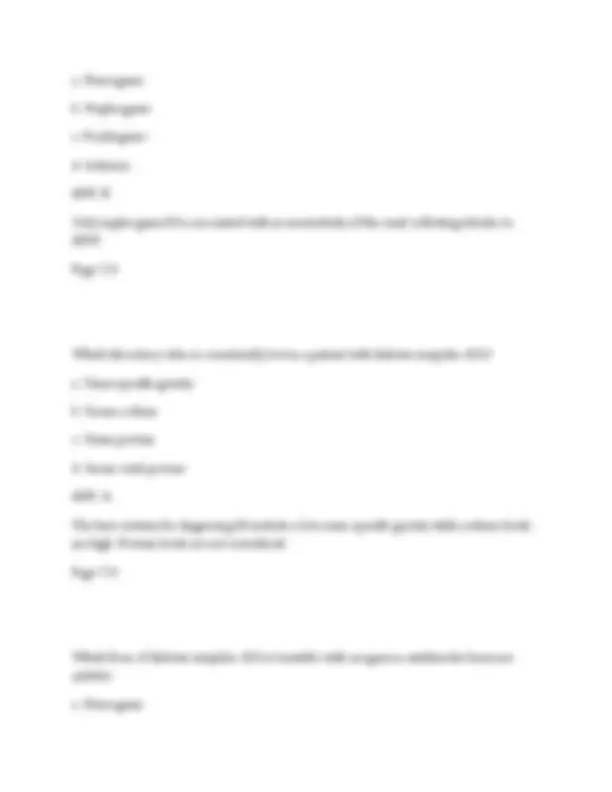
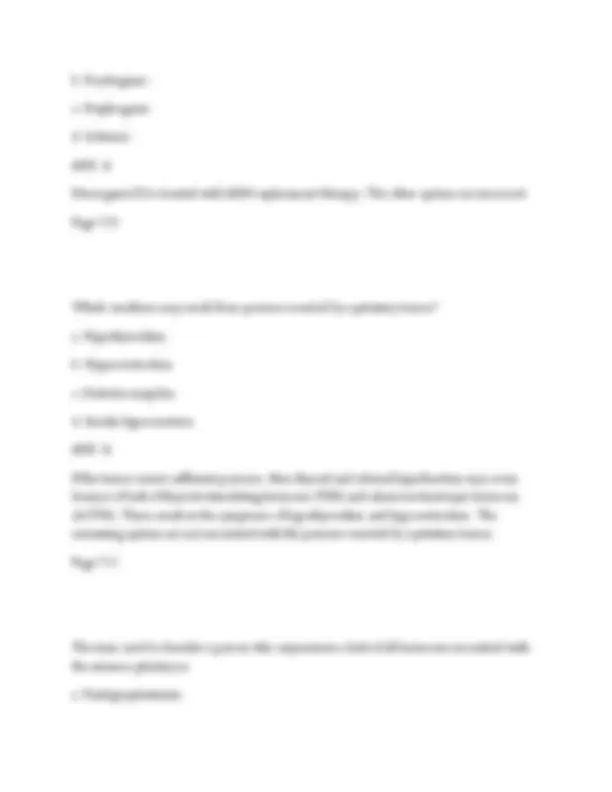
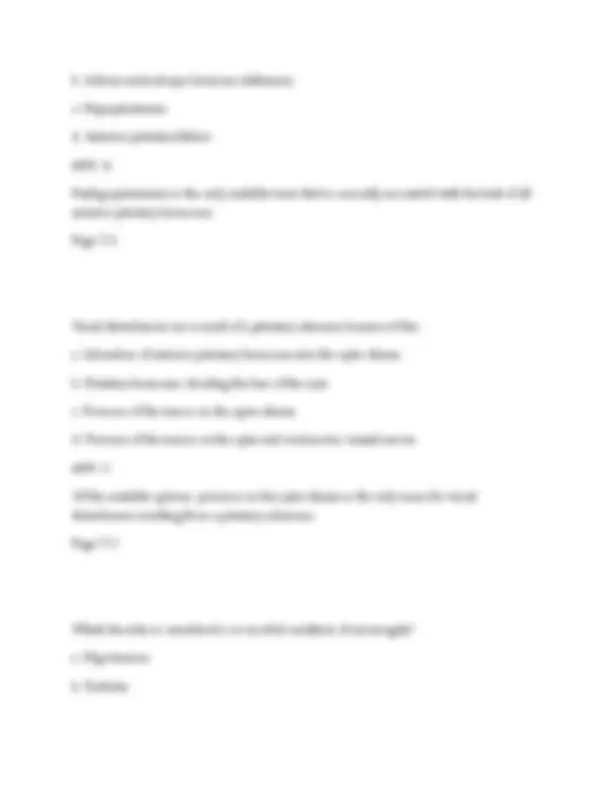
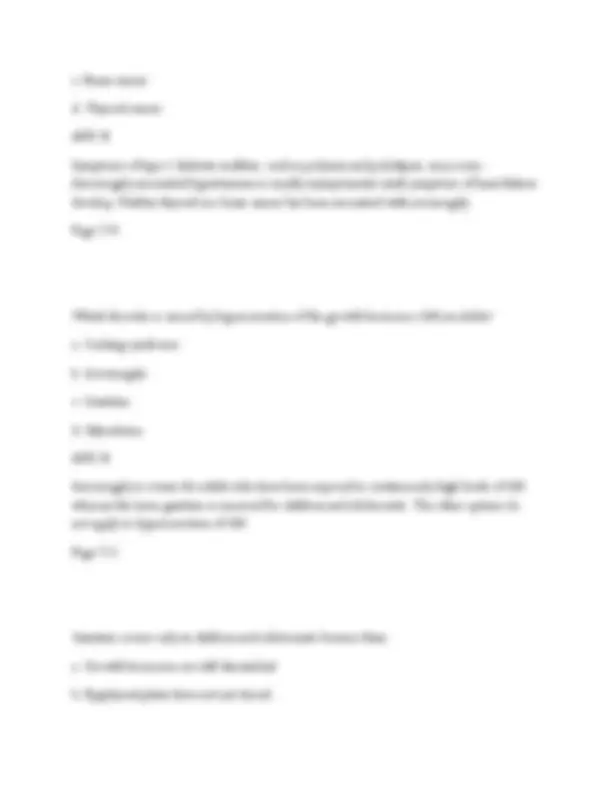
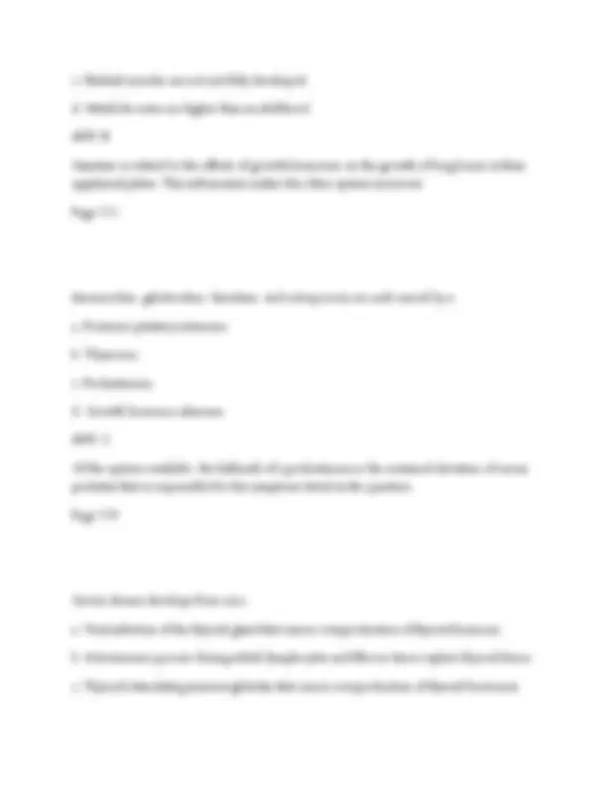
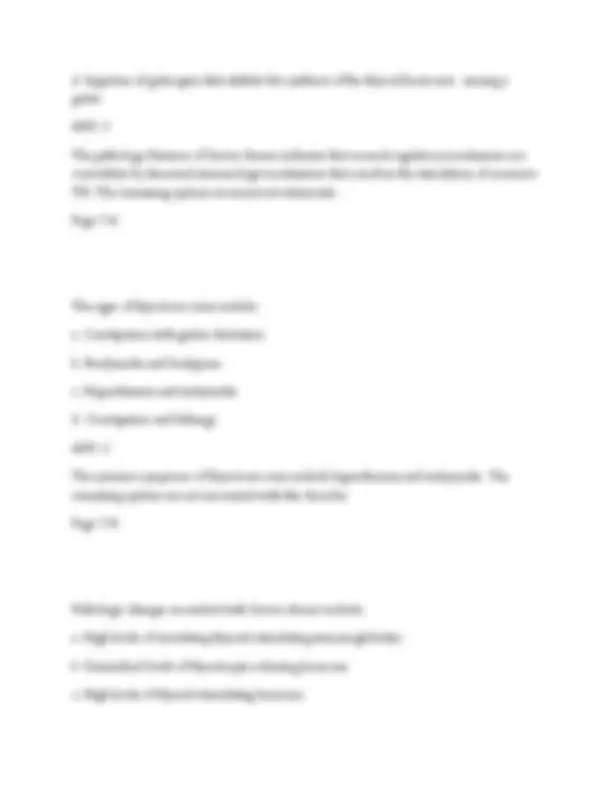
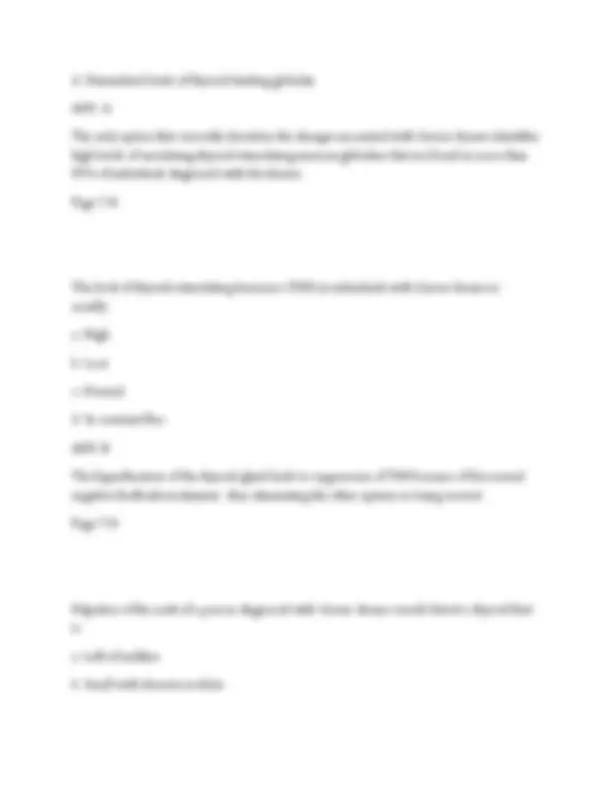
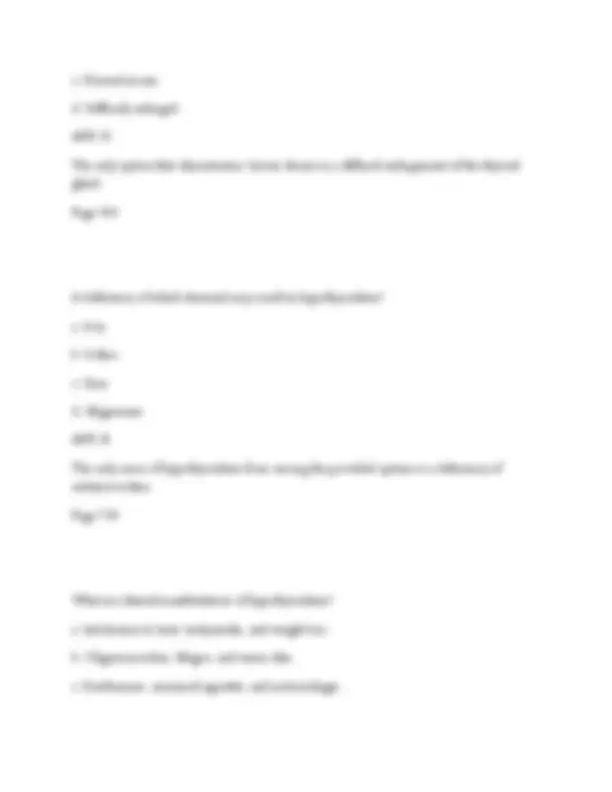
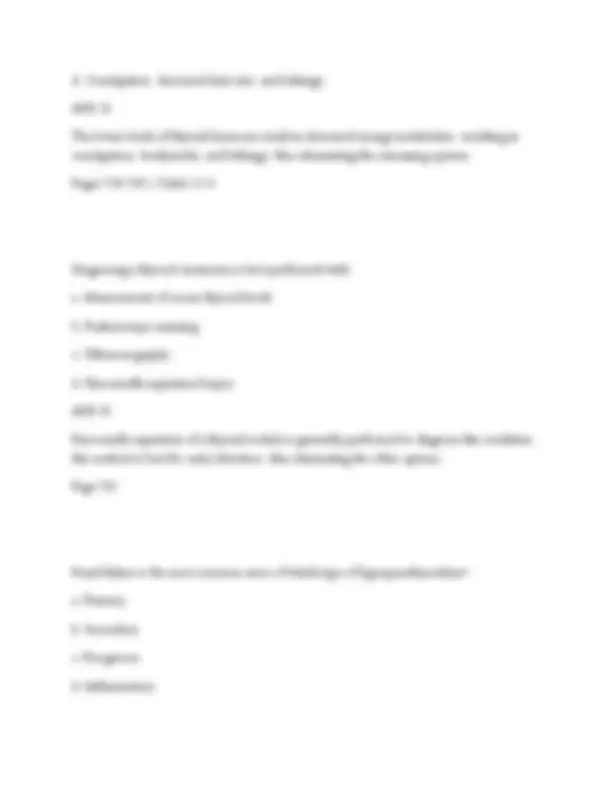
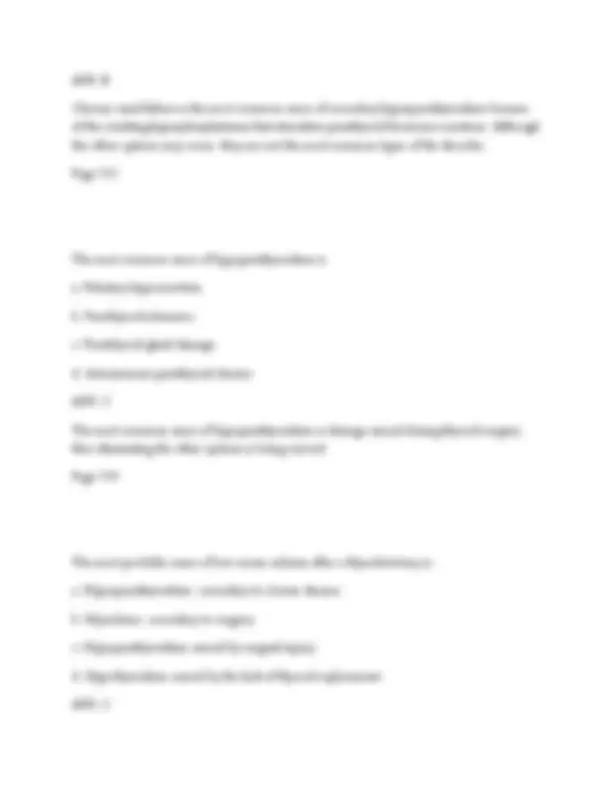

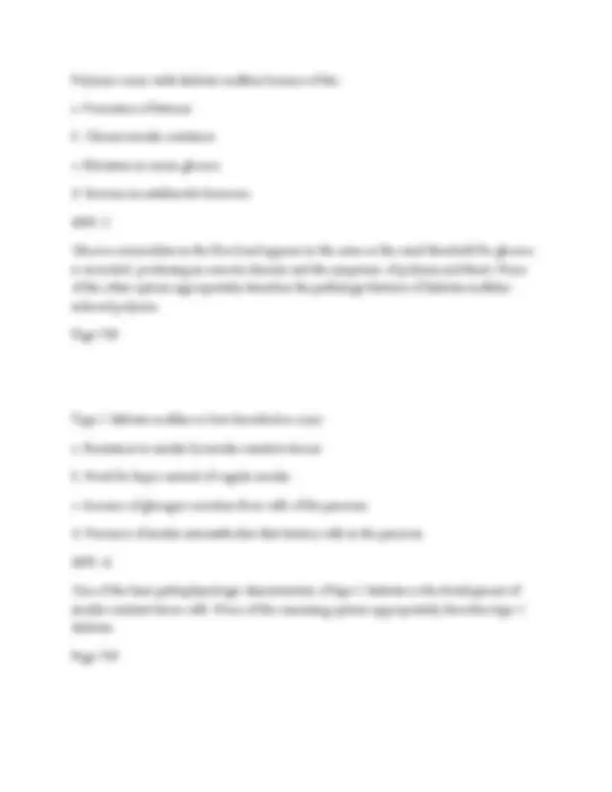
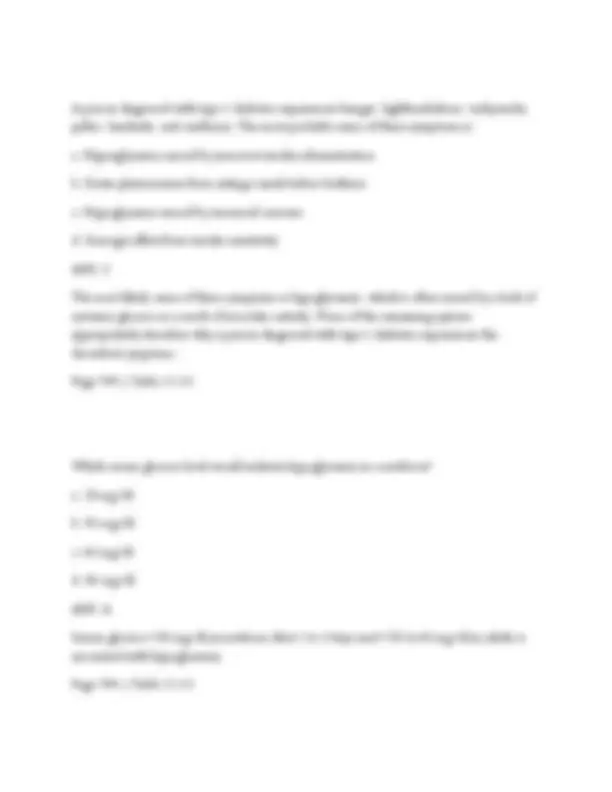
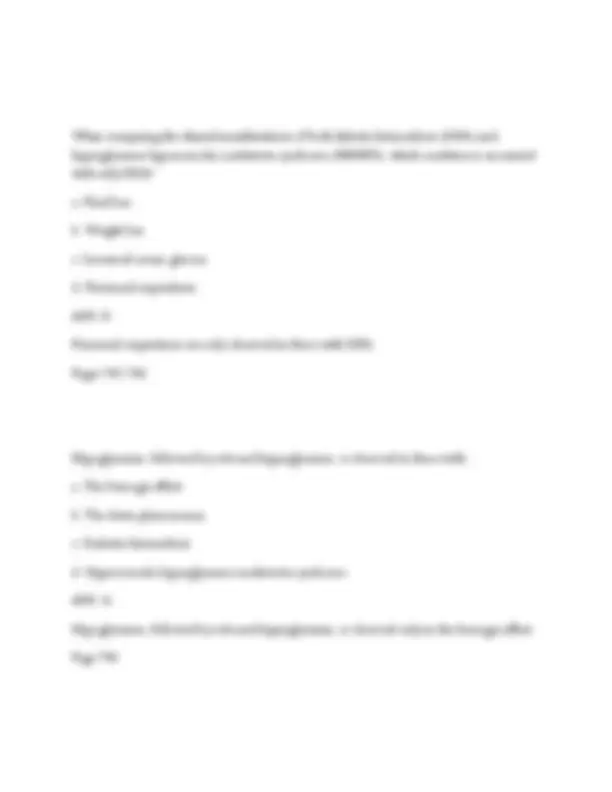
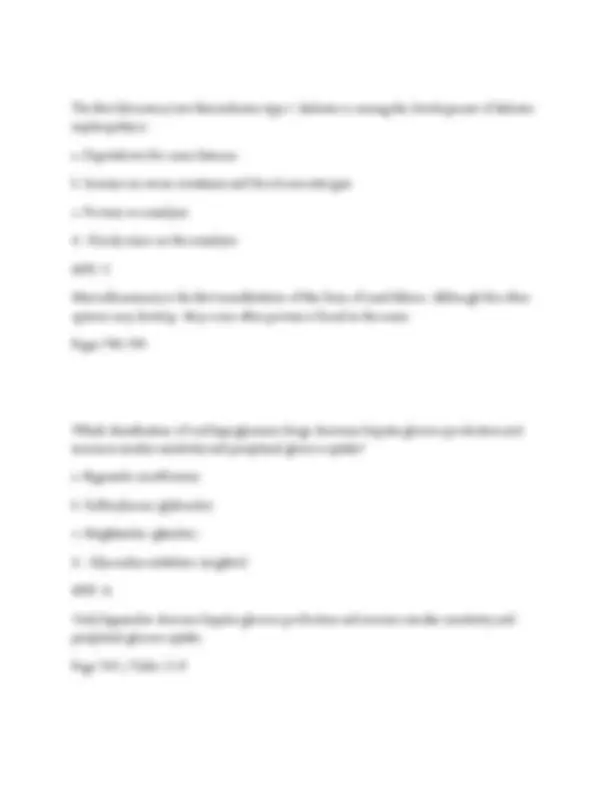
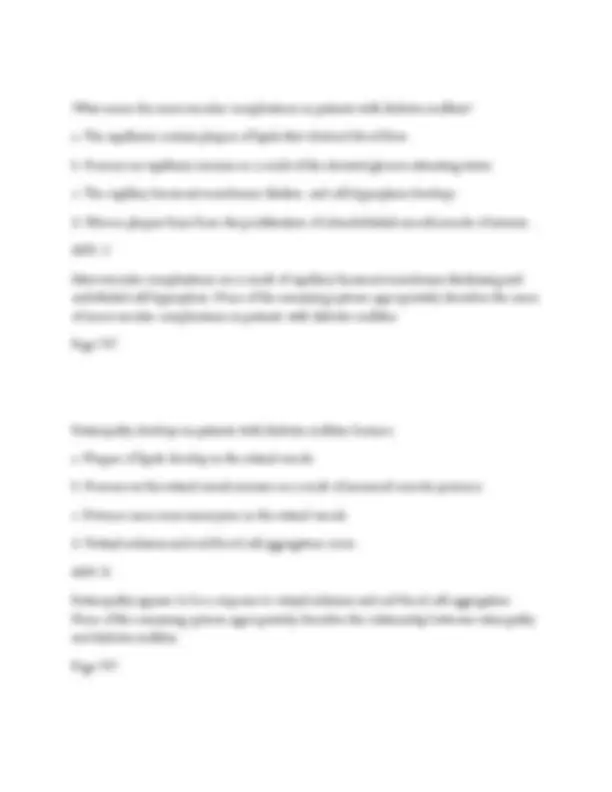
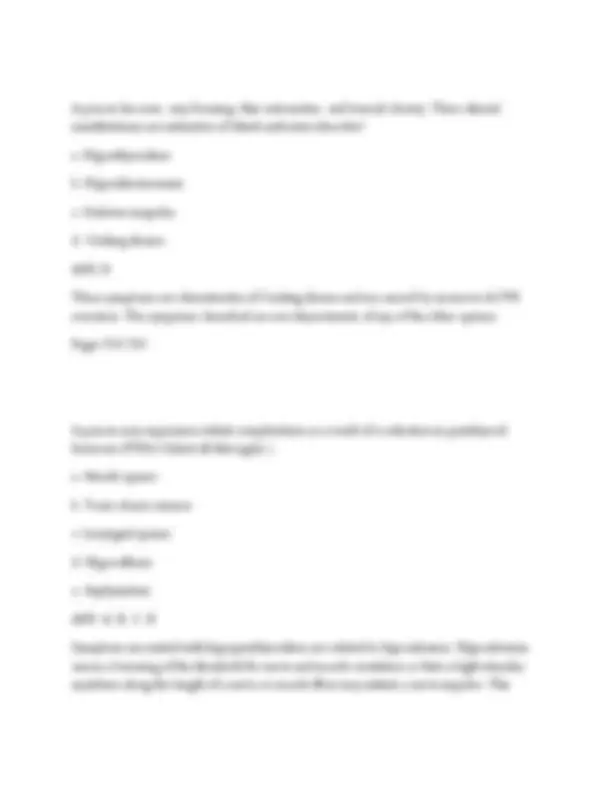
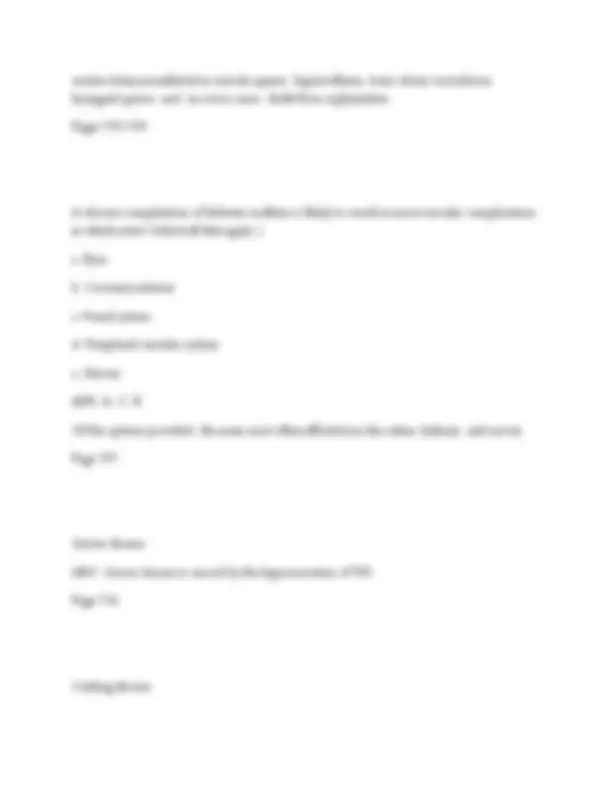
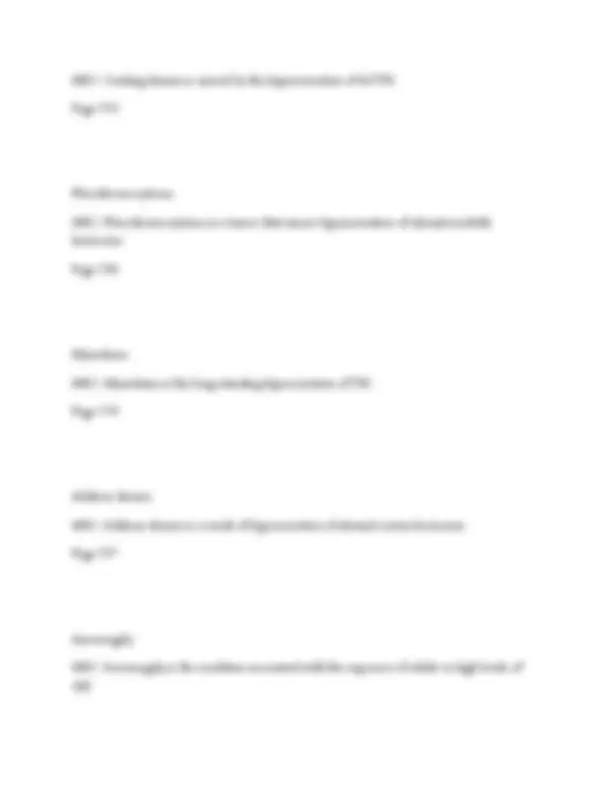
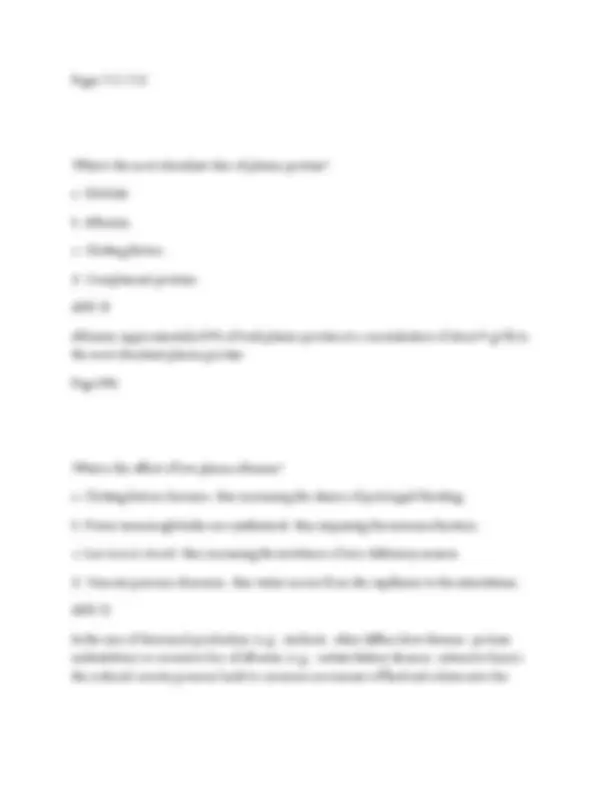
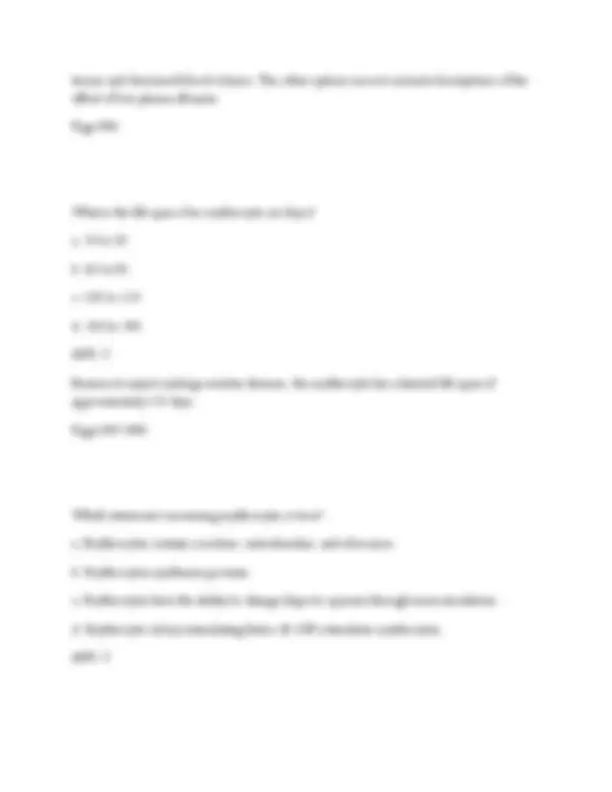
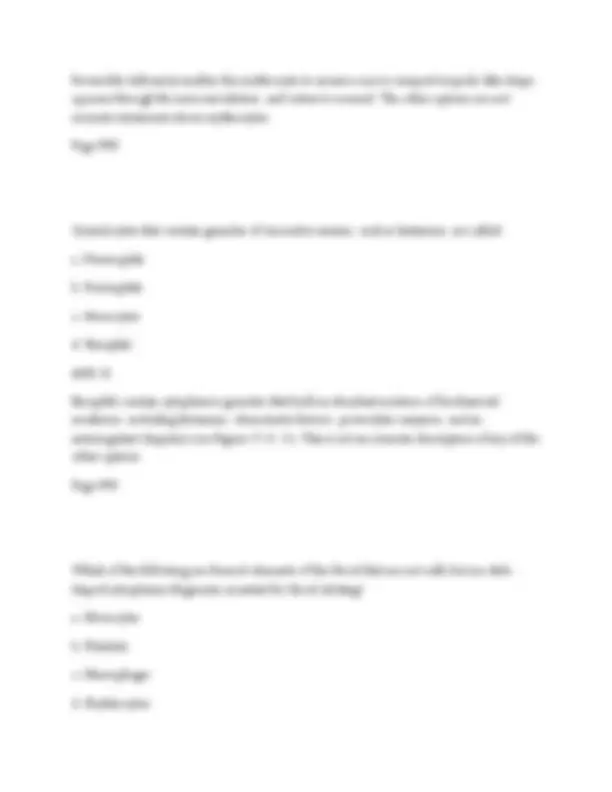
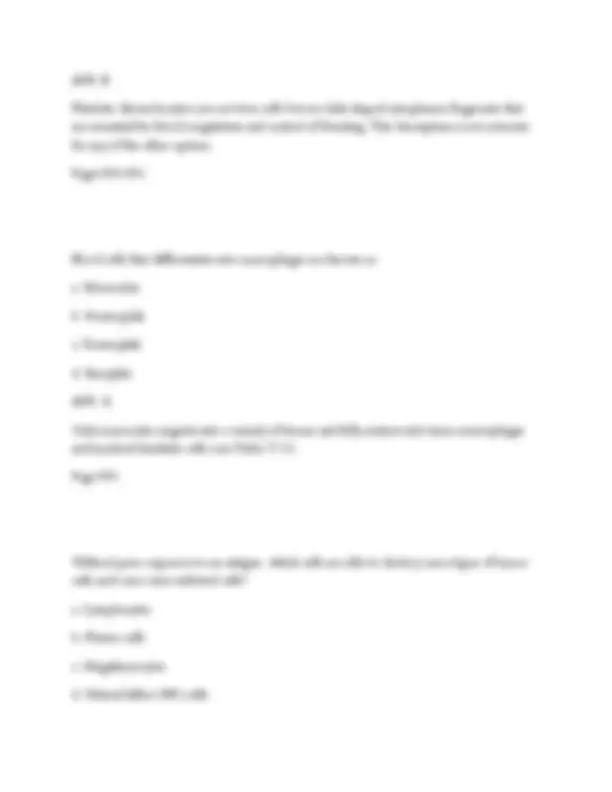
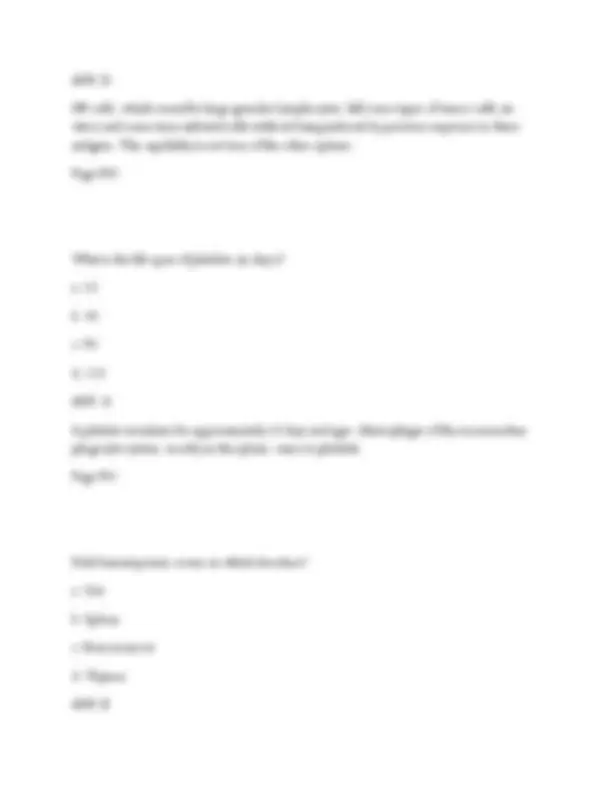
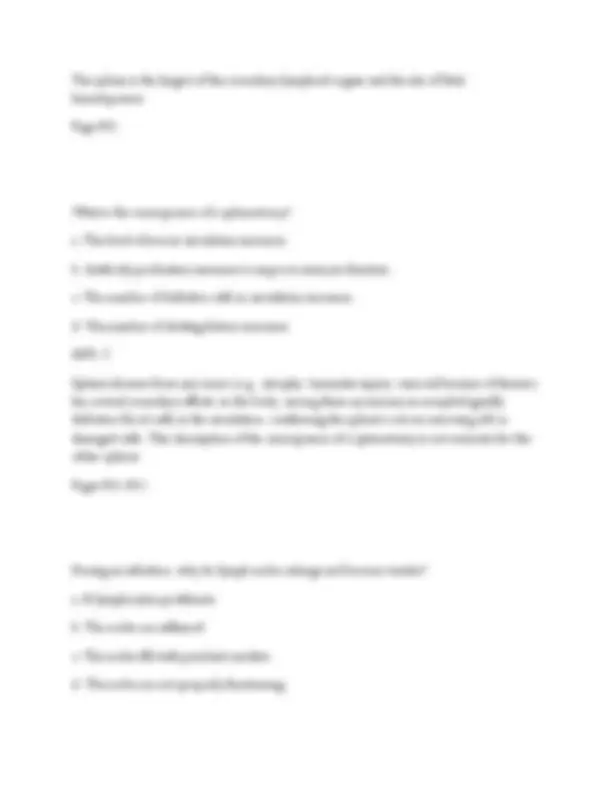
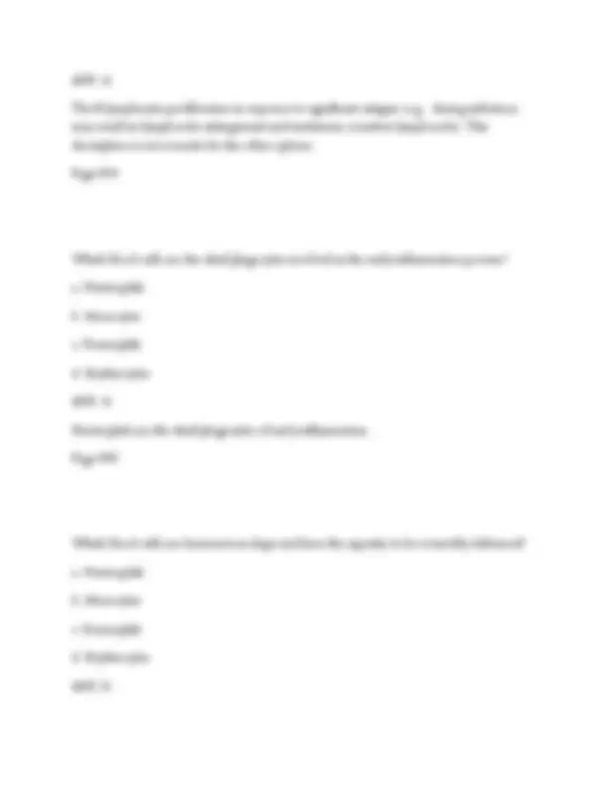
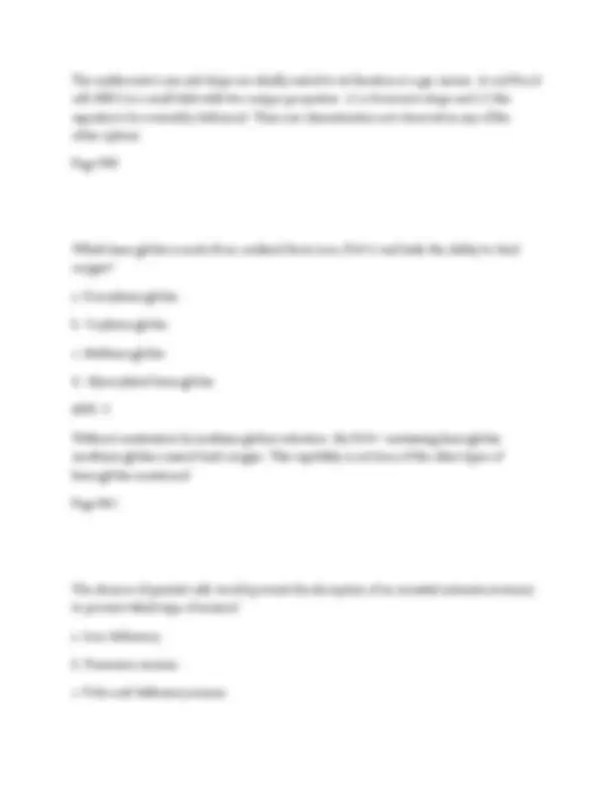
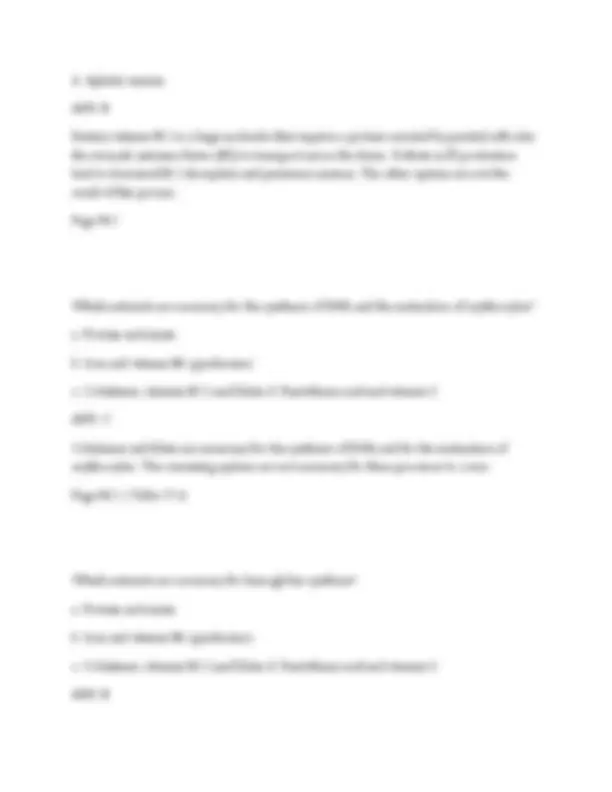
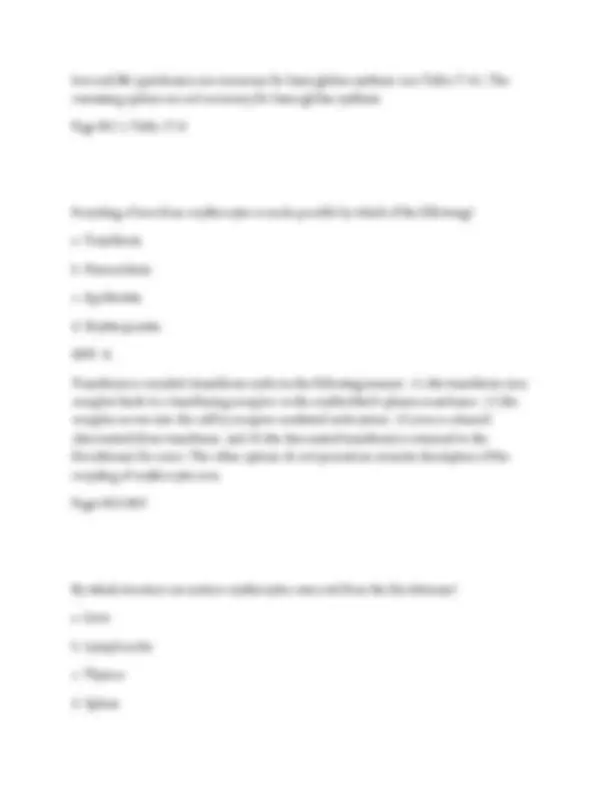
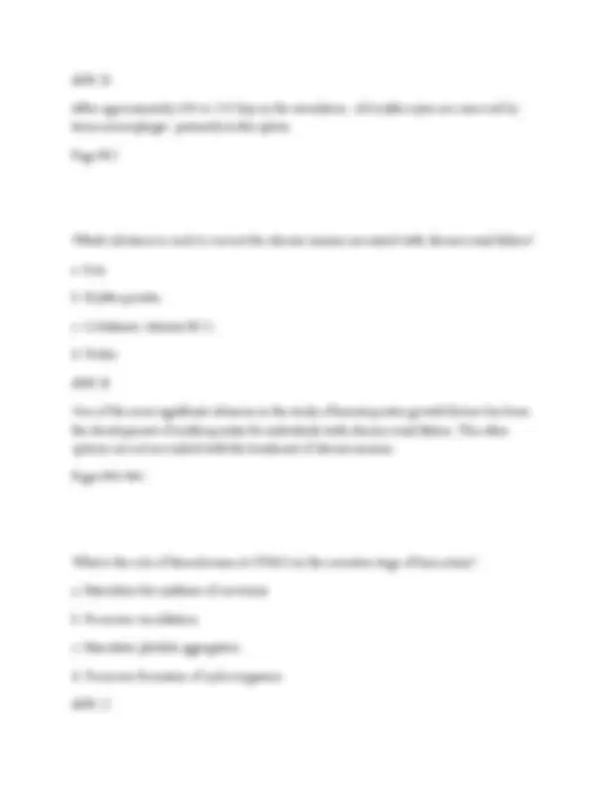
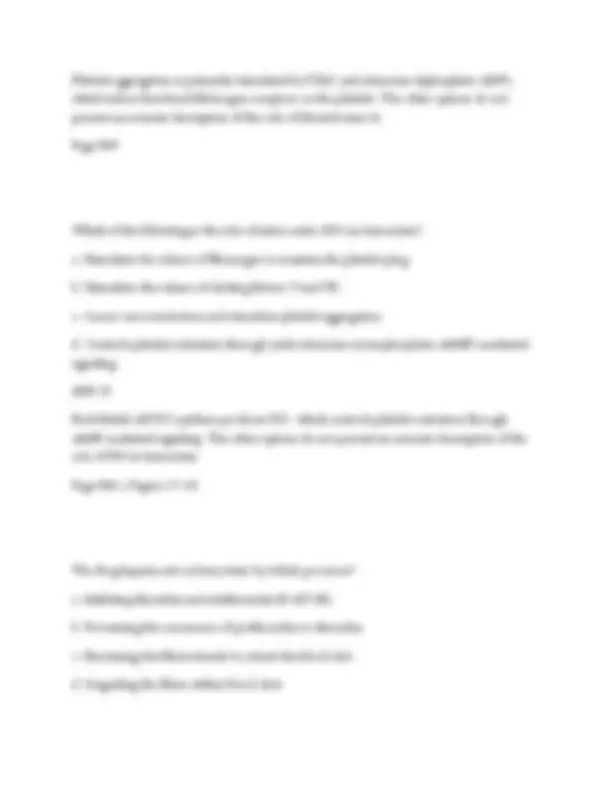
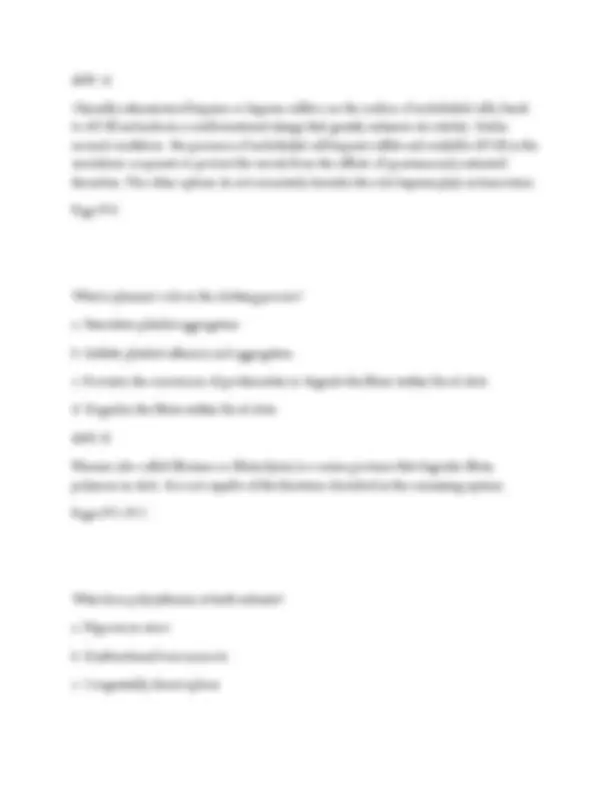
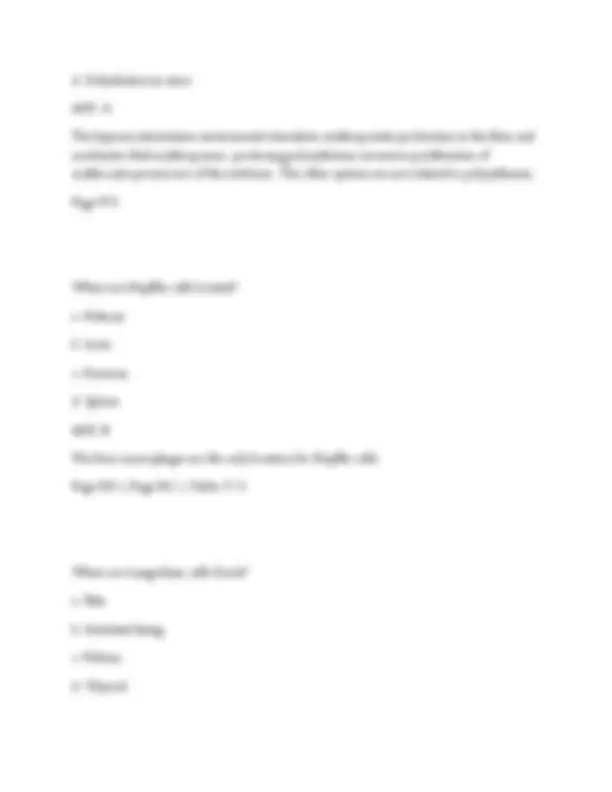
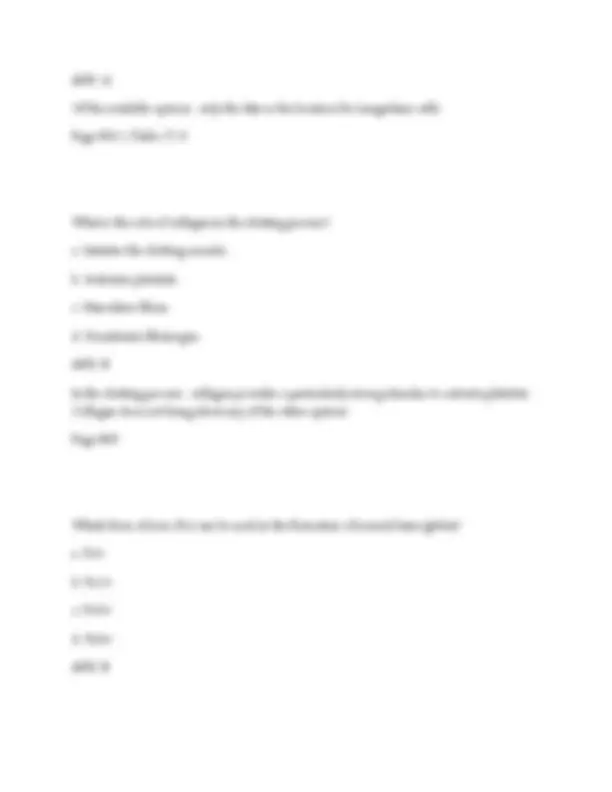
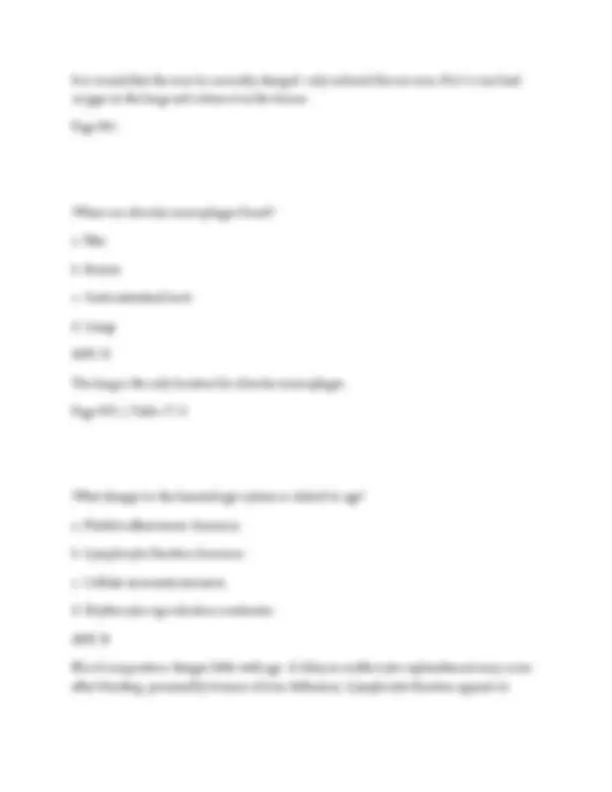
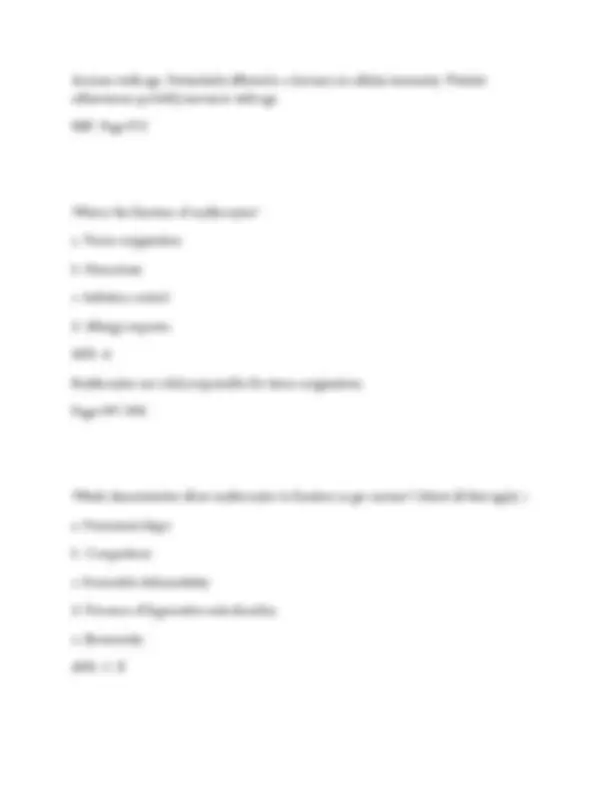
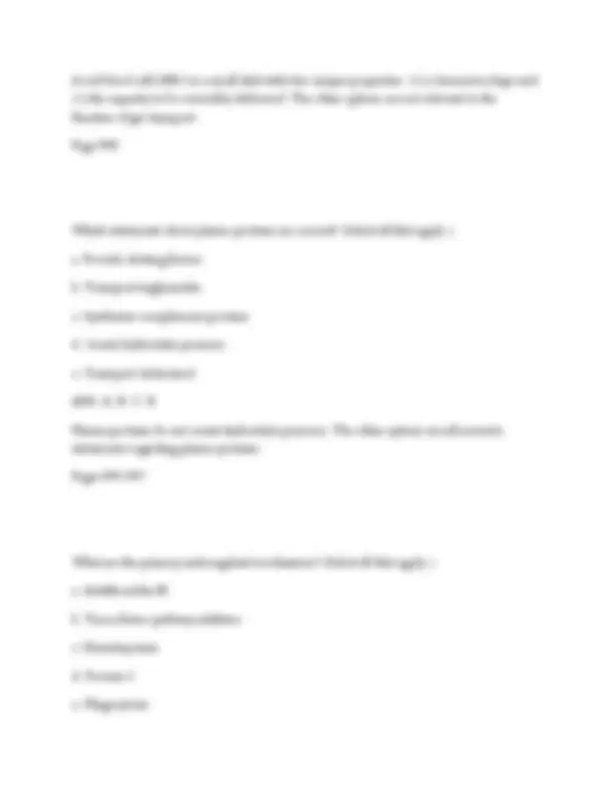
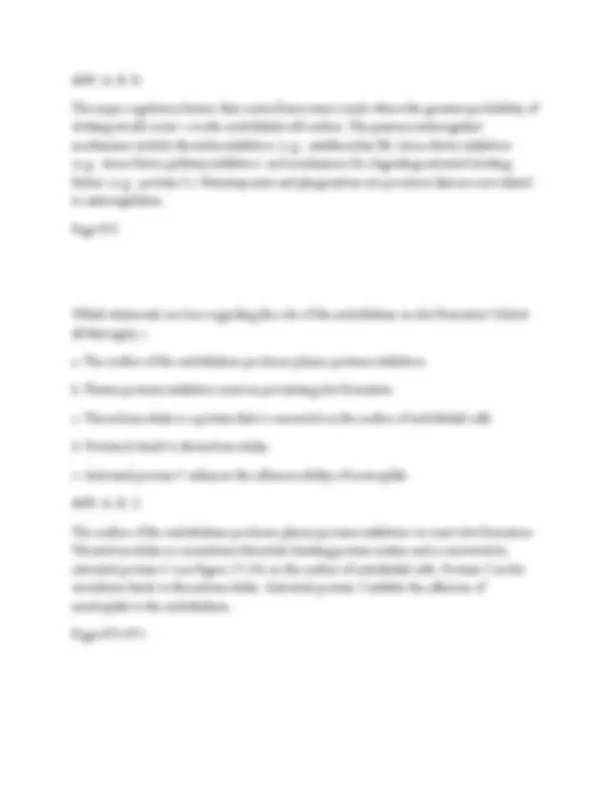
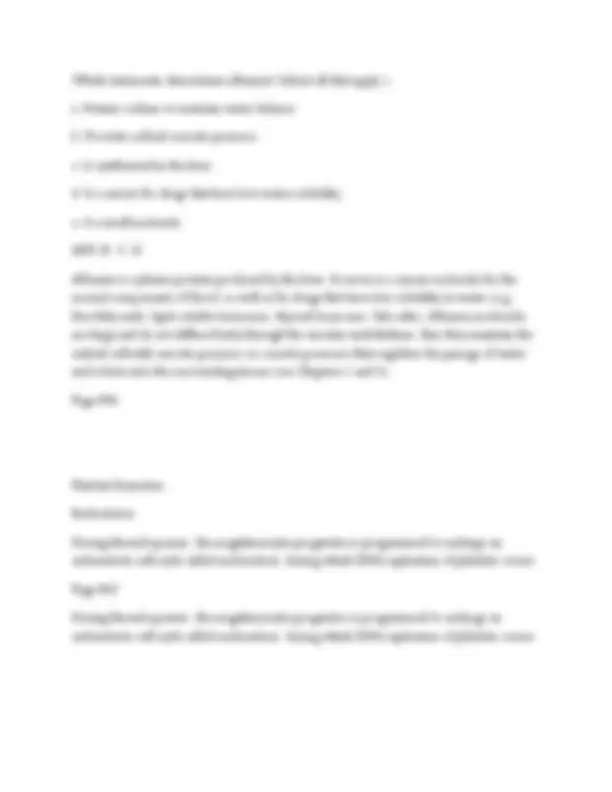
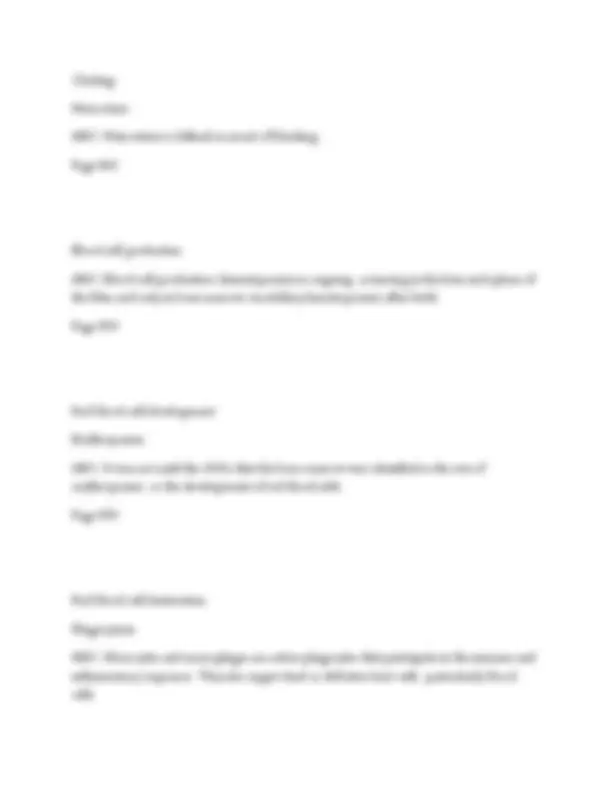
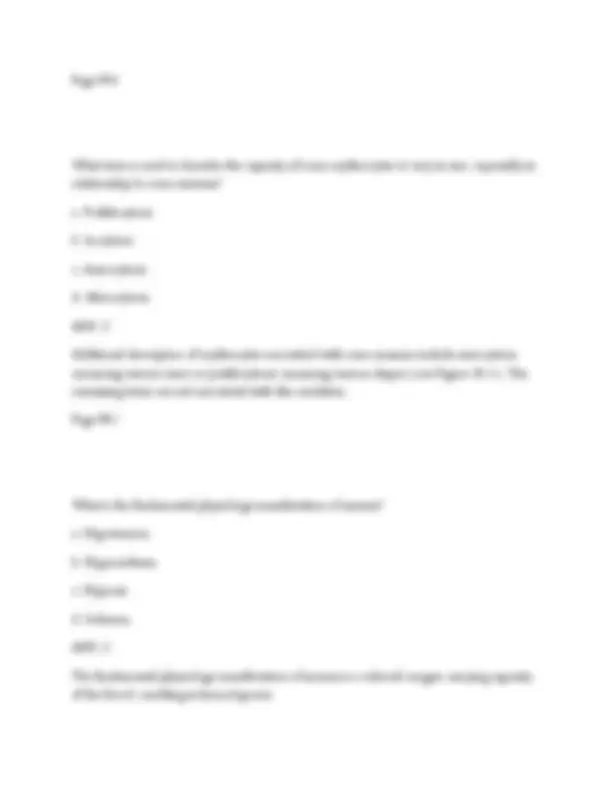
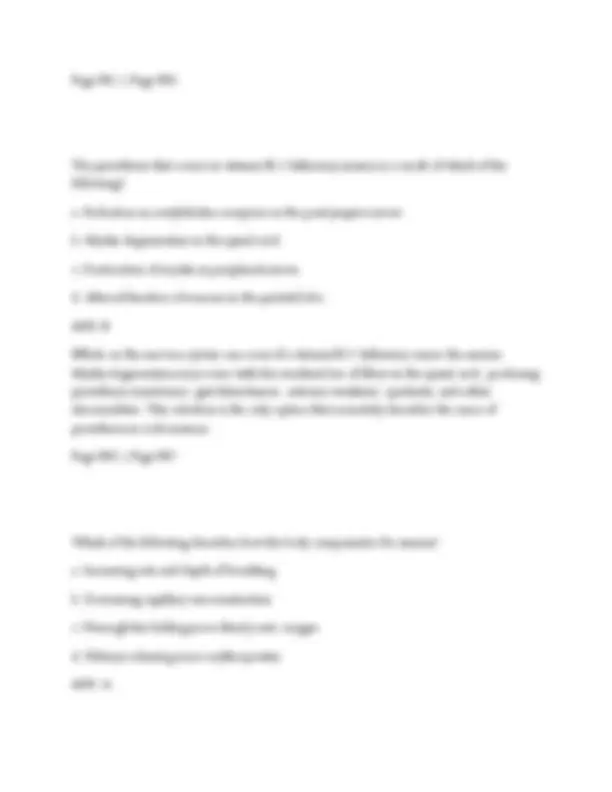
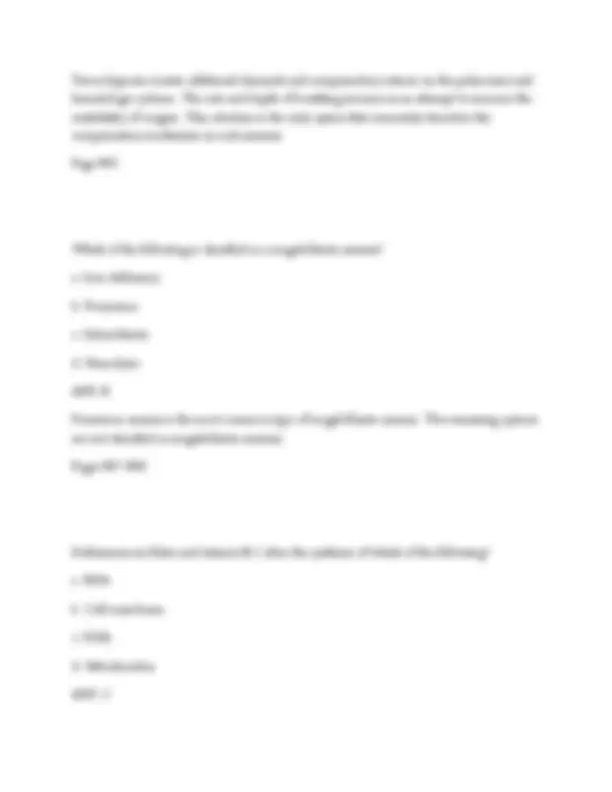
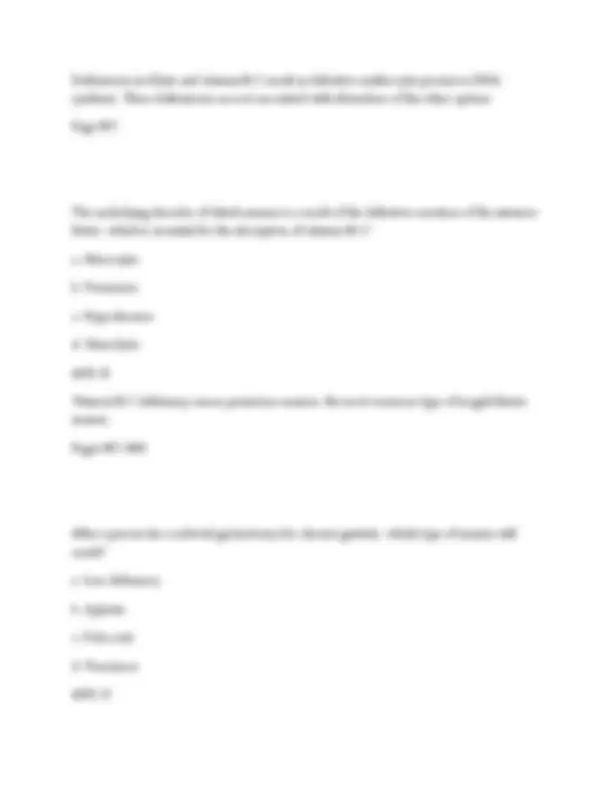
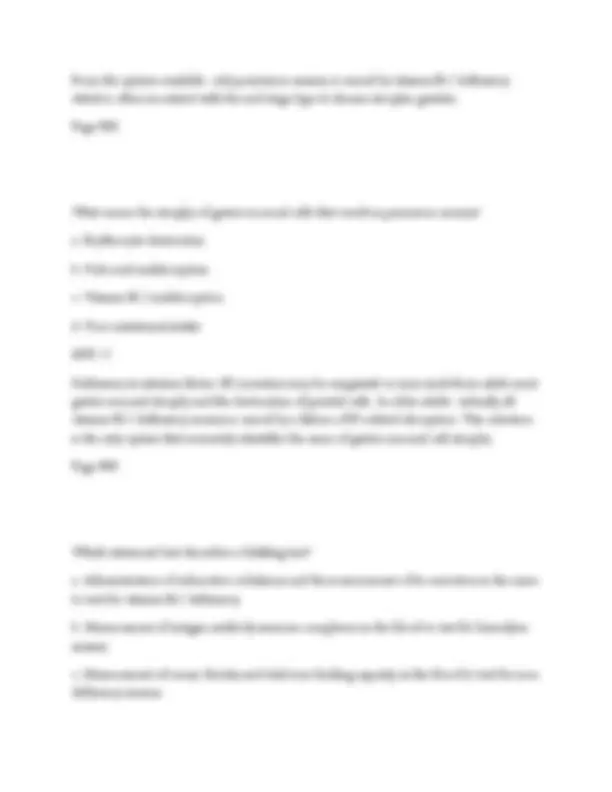
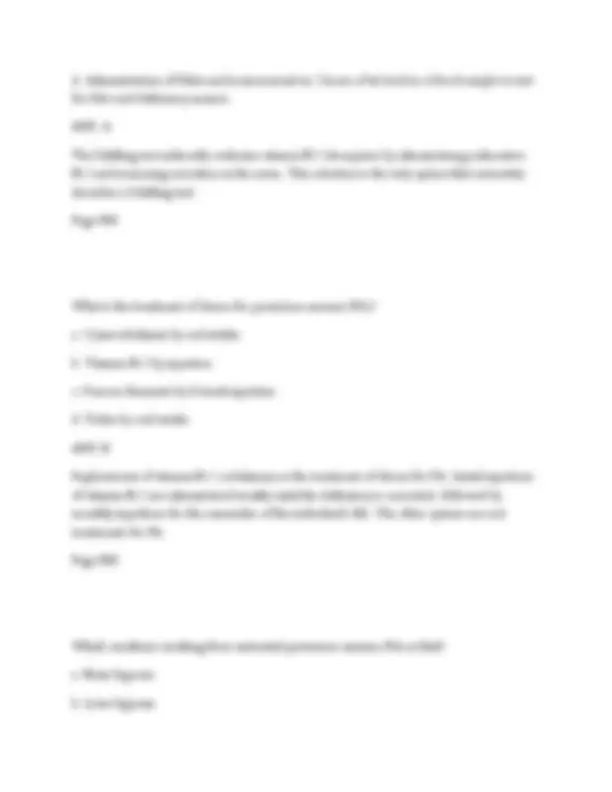
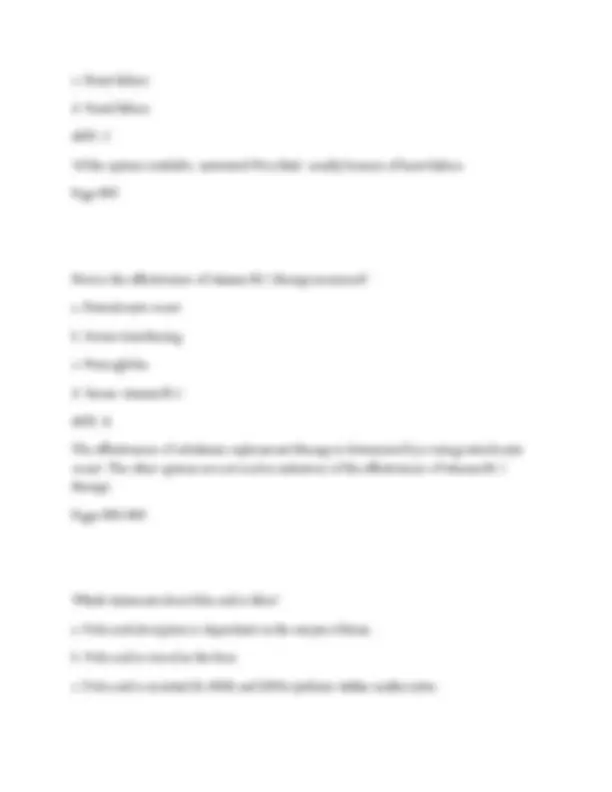
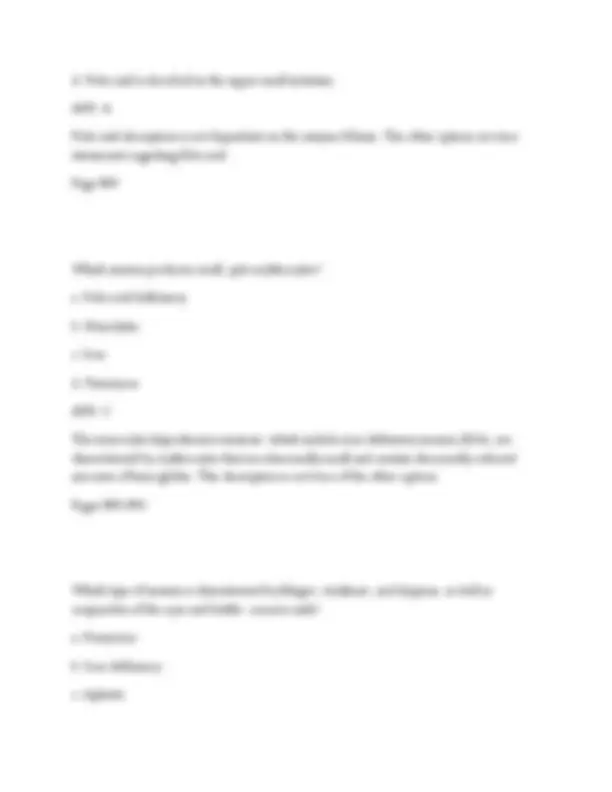
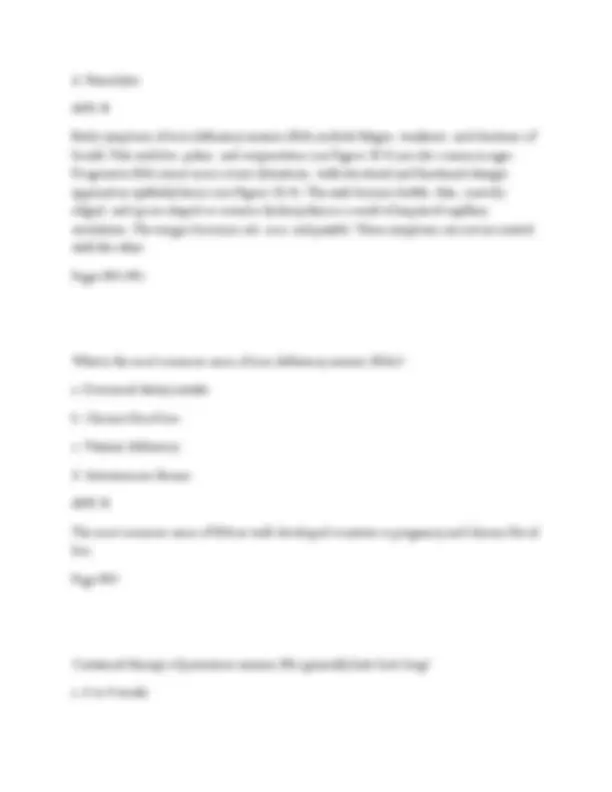
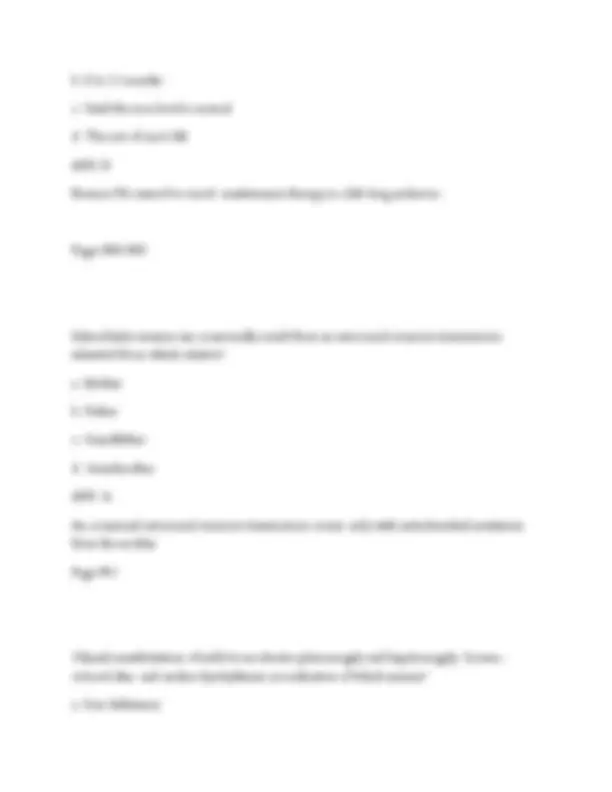
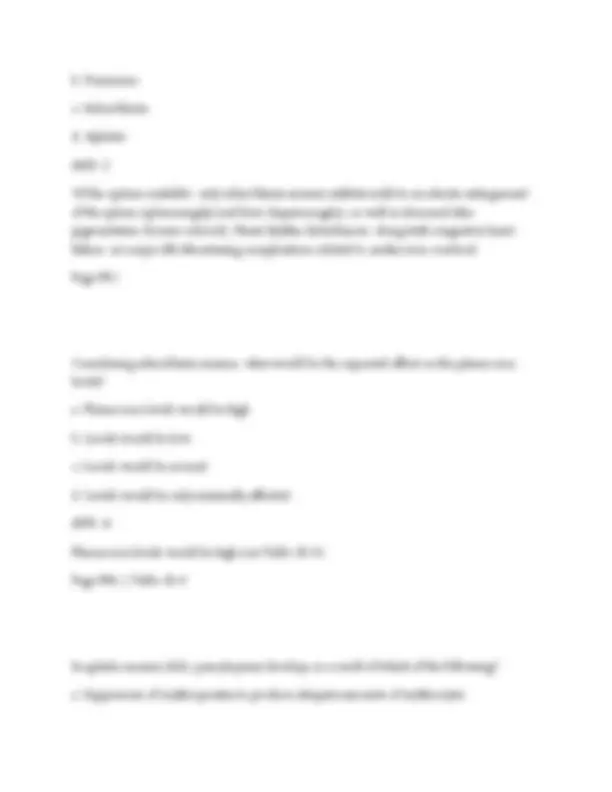
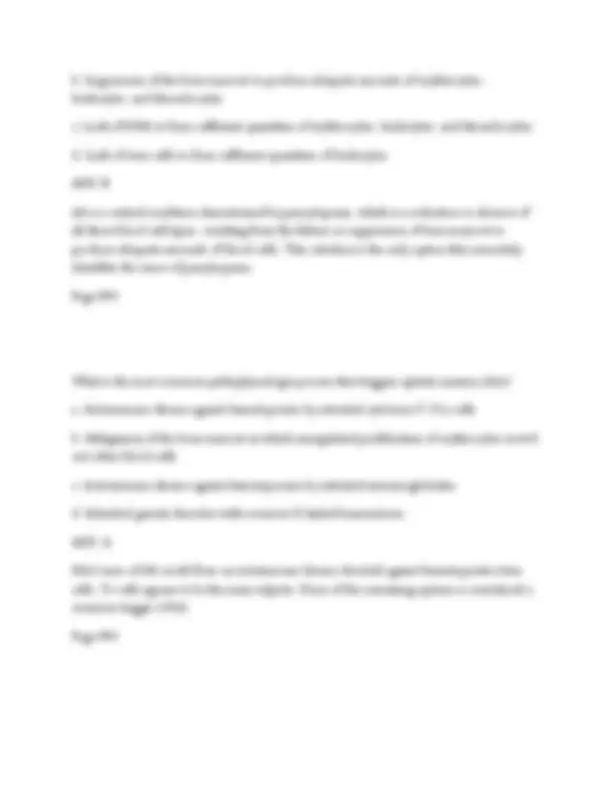
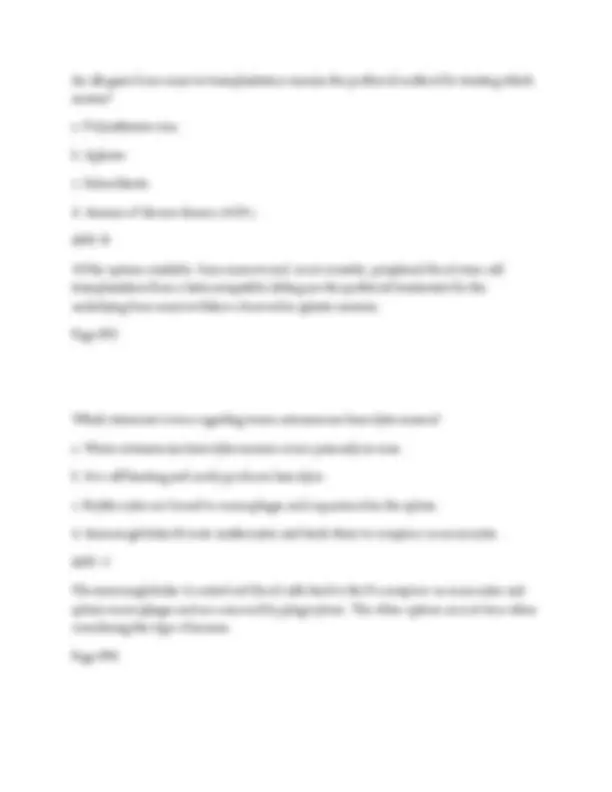
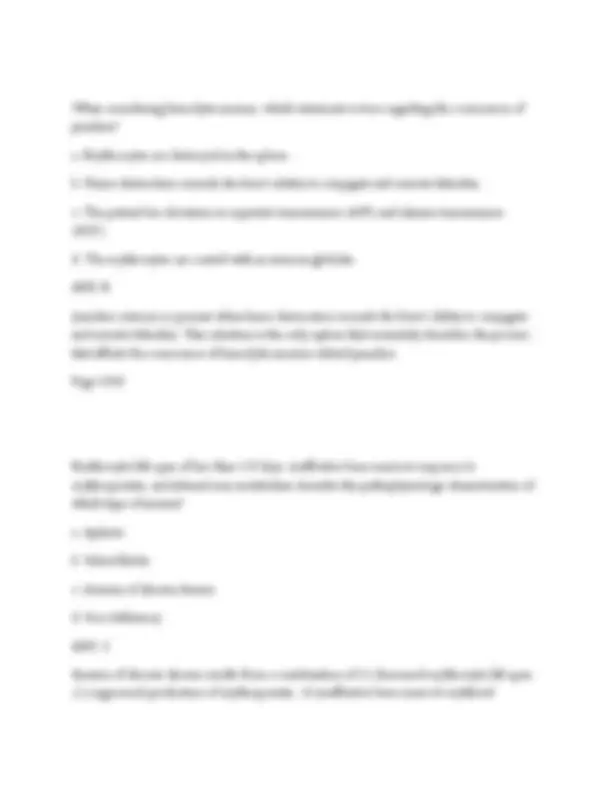
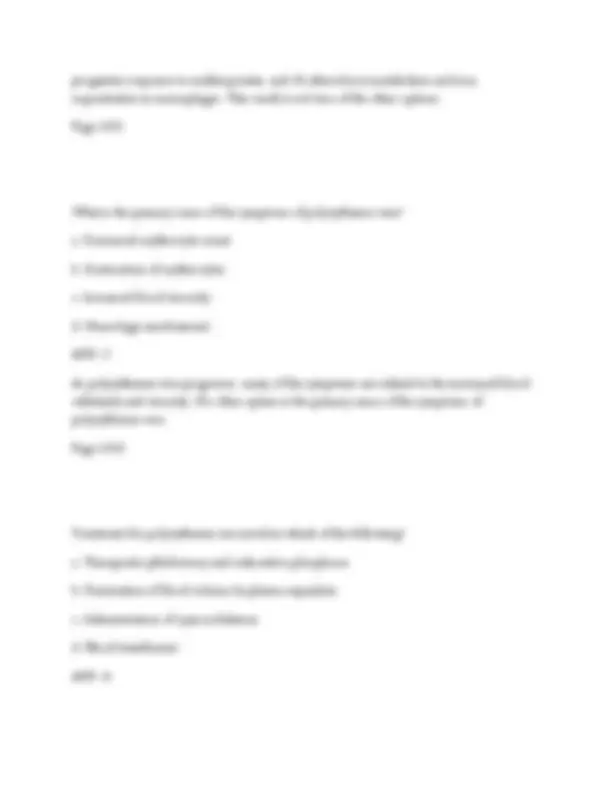
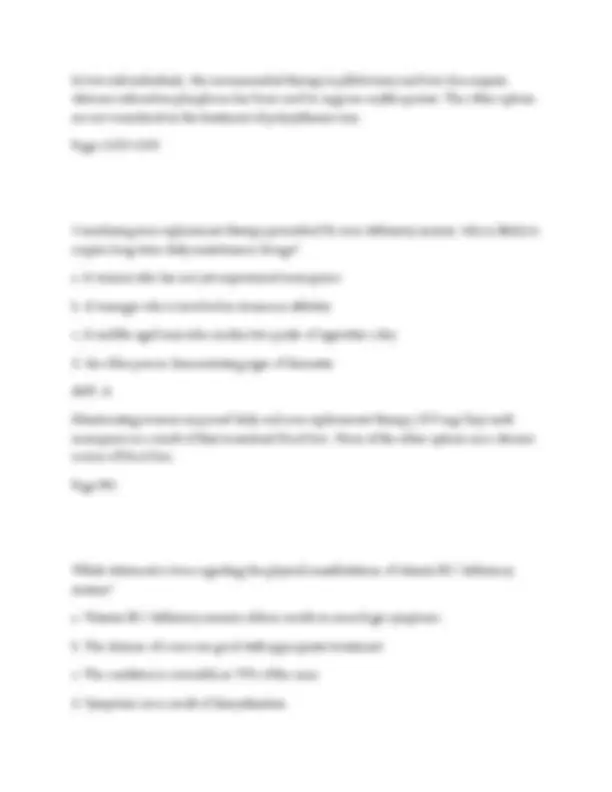
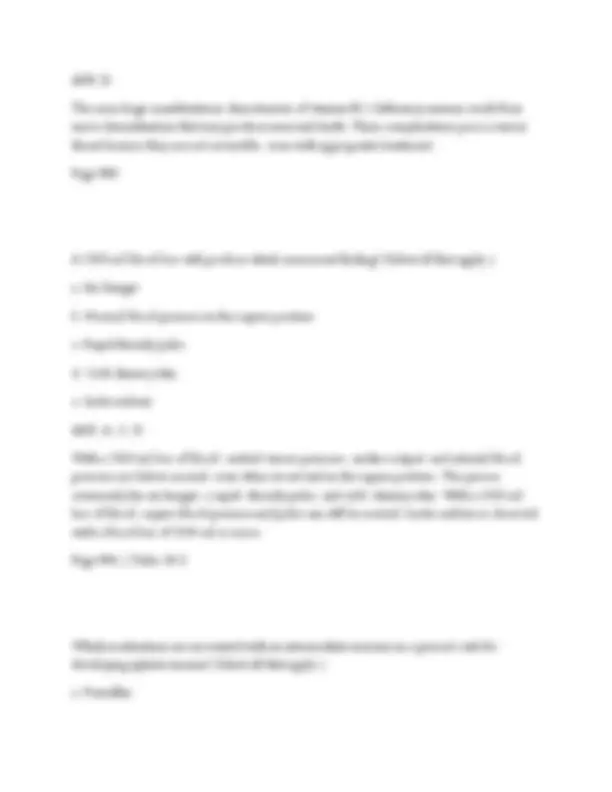
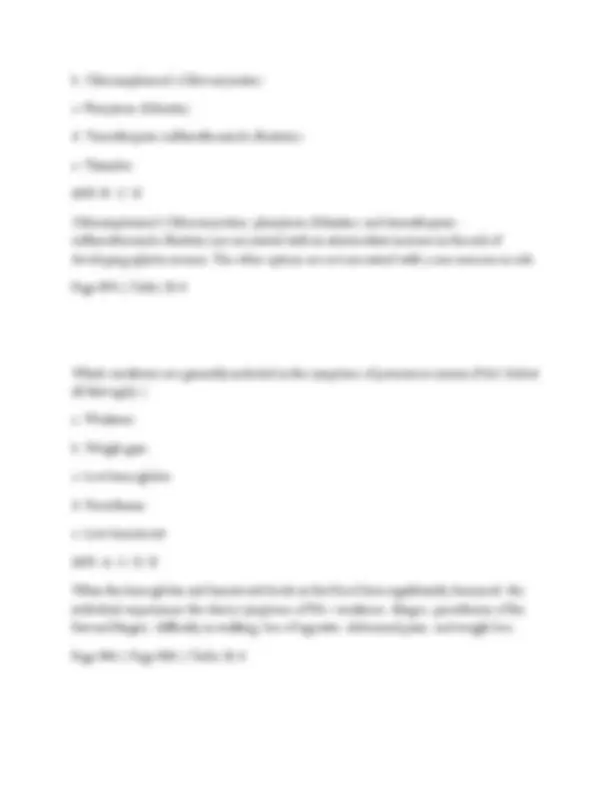
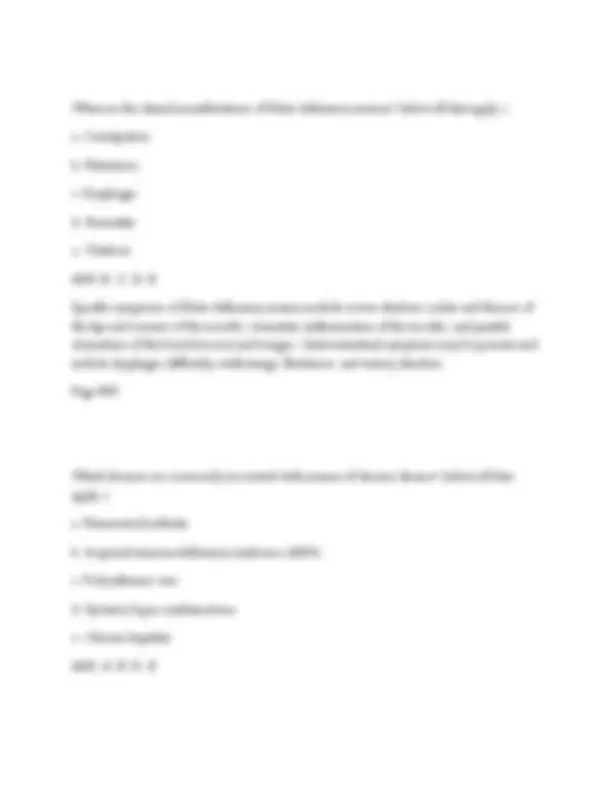
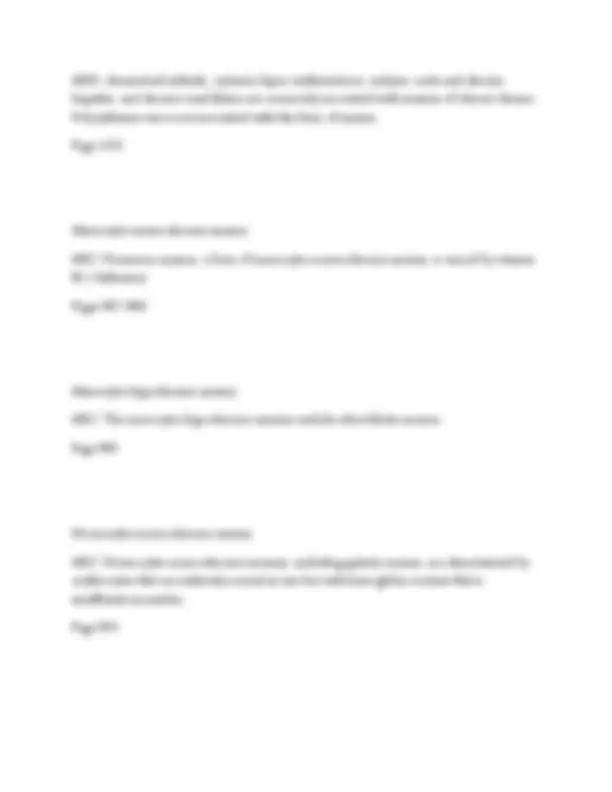
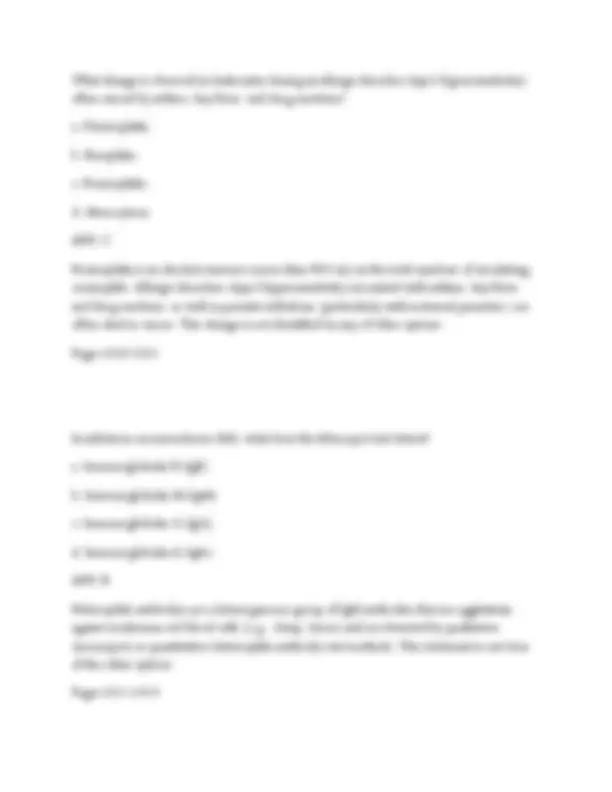
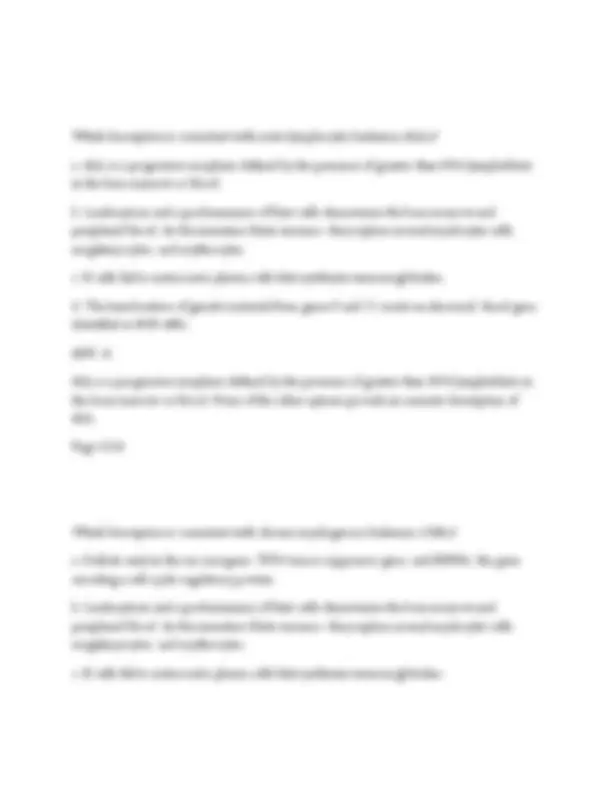
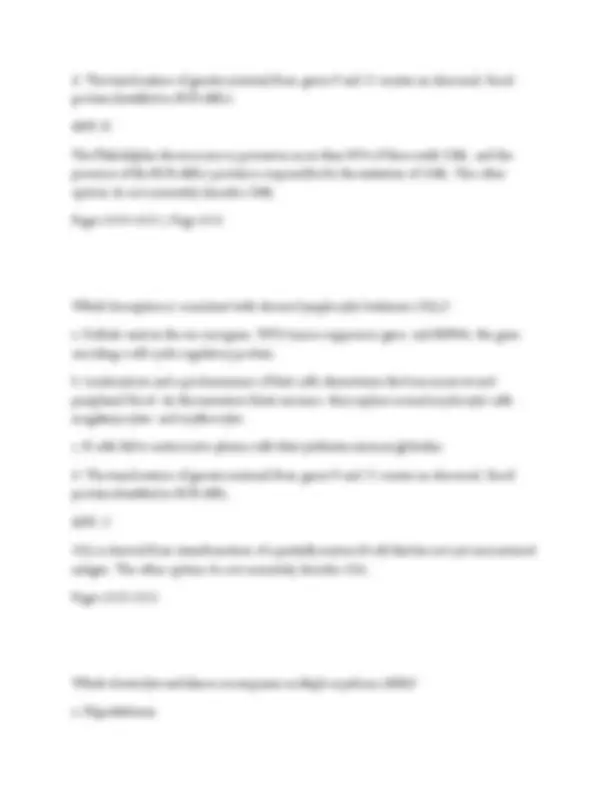


Study with the several resources on Docsity

Earn points by helping other students or get them with a premium plan


Prepare for your exams
Study with the several resources on Docsity

Earn points to download
Earn points by helping other students or get them with a premium plan
Community
Ask the community for help and clear up your study doubts
Discover the best universities in your country according to Docsity users
Free resources
Download our free guides on studying techniques, anxiety management strategies, and thesis advice from Docsity tutors
This document offers a valuable collection of questions and answers covering key concepts in pathophysiology, specifically focusing on endocrine and cardiovascular systems. it delves into the mechanisms of diseases like diabetes mellitus, hypothyroidism, addison's disease, and various heart conditions. The q&a format facilitates self-assessment and knowledge reinforcement for students studying these topics. the detailed explanations enhance understanding of complex physiological processes and their disruptions in disease states. This resource is particularly useful for medical and nursing students.
Typology: Exams
1 / 170

This page cannot be seen from the preview
Don't miss anything!





























































































Explain the pathophysiology associate with Type 1 and Type 2 DM ANS :->> Is the result of an autoimmune mediated specific loss of beta cells in the pancreatic islet. One of the basic patho of type 2 DM is the development of insulin resistant tissue cells. Explain what occurs in panhypopituitarism. ANS :->> Panhypopituitarism is the term correctly associated with the lack of all anterior pituitary hormones. List the clinical manifestations of hypothyroidism. ANS :->> The individual develops a low basal metabolic rate, cold intolerance, lethargy, tiredness, and slightly lower basal body temperature. Differentiate diabetes insipidus, diabetes mellitus and SIADH. ANS :->> DM: is not a single disease but a group of clinical heterogeneous disorders that have glucose intolerance in common. DI: is an insufficiency of ADH, leading to polyuria and polydipsia.
SIADH: is characterized by high levels of ADH in the absence of normal physiologic stimuli for its release. The symptom common to all these conditions is thirst. What causes the microvascular complications of DM. ANS :->> Microvascular complications are a result of capillary basement membranes thickening and endothelial cell hyperplasia. What is the cause of diabetes insipidus. ANS :->> Inability of the kidney to increase permeability of water. This causes excretions of large volumes of dilute urine, leading to increase in plasma osmolality. Describe the pathophysiological changes associated with Addison's Disease. ANS :->> Addison disease is a result of hyposecretion of adrenal cortex hormones. Describe the pathophysiological changes associated with hypoparathyroidism. ANS :->> The most common cause of hyperparathyroidism is damage caused during thyroid surgery. In hypothyroidism a lack of circulating PTH causes a depressed serum calcium level resulting in the symptomatology mentioned in the stem.
ANS :->> A number of serious complications are associated with any type of DM and include microvascular (retinopathy, nephropathy, and neuropathy) and macrovascular (CAD, CVA, PVD) disease and infection. What happens during hypoglycemia? ANS :->> A person with type 1 DM experiences hunger, lightheadedness, tachycardia, pallor, HA and confusion. The most likely cause of these symptoms is hypoglycemia, which is often caused by a lack of systemic glucose resulting from muscular activity. What is the metabolic syndrome? ANS :->> It also has been called the insulin resistance syndrome or syndrome X. It is a clustering of clinical traits occurring together that increase the risk for accelerated cardiovascular disease and type 2 DM. Combination of medical disorders that increase the risk of developing cardiovascular disease and DM. Describe how DM causes peripheral neuropathy ANS :->> It is a form of "dying back" neuropathy, in which the distal portions of the neurons are initially and eventually more severely affected. The earliest morphologist change in both the peripheral nerves and CNS is axonal degeneration that preferentially involves sensory nerve fibers, particularly the smaller polymodal unmyelinated peripheral C fibers and the larger myelinated A delta fibers. Trace the electrical activity of the heart.
ANS :->> Normally electrical impulses arise in the SA nose, which is often called the pacemaker of the heart.
List the indicators for an acute myocardial infarction (AMI). When coronary blood flow is interrupted for an extended period, myocyte necrosis occurs, these results in an MI. In the majority of cases of MI, the decrease in coronary flow is the result of atherosclerotic CAD, other causes include coronary spasm and coronary artery embolism. The first s/s of acute MI is usually sudden, severe CP. It's not possible to distinguish between angina and MI by s/s alone, although pain associated with MI tends to be more severe and prolonged. It may be described as heavy and crushing, such as a "truck sitting on my chest," radiation to the neck, jaw, back, shoulder or left arm is common. Some individuals (especially older adults or those with DM) experience no pain, thereby having a "silent" infarction. Infarction often stimulates a sensation of unrelenting indigestion. Nausea and vomiting may occur because of reflex stimulation of vomiting centers by pain fibers. Vasovagal reflexes from the area of the infracted myocardium also may affect the GI tract. Catecholamine release results in sympathetic stimulation, producing diaphoresis and peripheral vasoconstriction that cause the skin to become cool and clammy. List the clinic indicator for a coronary thrombus. These individuals usually have marked elevations in the ST segments on ECH and are categorized as having a STEMI. Define pericarditis It's an acute inflammation of pericardium. Most individuals with acute pericarditis describe several days of fever, myalgias, and malaise followed by the sudden onset of severe CP that worsens with respiratory movements and with lying down. Although the pain may radiate to the back, it's generally felt in the anterior chest and may be confused initially with the pain of acute MI. Individuals with acute pericarditis also may report dysphagia, restlessness,
irritability, anxiety, and weakness. It is also the most common cardiovascular complication of HIV infection. List the causes and types of cardiomyopathy Cardiomyopathies are a diverse group of disease that primarily affects the myocardium. Most are the result of underlying cardiovascular disorders, such as ischemic heart disease and HTN. Cardiomyopathies also can be secondary to infectious disease, exposure to toxins, systemic connective tissue disease, infiltrative and proliferative disorders, or nutritional deficiencies. Dilated cardiomyopathy causes decreased ejection fraction, increased end diastolic and residual volumes, decreased ventricular stroke volume, and biventricular failure. Dilated cardiomyopathy (congestive cardiomyopathy) is characterized by ventricular dilation and grossly impaired systolic function, leading to dilated heart failure. Hypertrophic caridomyopathy is characterized by thickening of the septal wall, which may cause outflow obstruction to the left ventricular outflow tract. Restrictive cardiomyopathy may occur idopathically or as a cardiac manifestation of systemic diseases, such as scleroderma, amylodosis, sarcoidosis, lymphoma, and hemochromatosis, or a number of inherited storage diseases. Discuss the effect of HTN on the kidney In the kidney vasoconstriction and resultant decreased renal perfusion cause tubular ischemia and preglomerular arteriopathy. Describe the blood flow through the heart The pumping action of the heart consists of contractions and relaxation of the myocardial layer of the heart wall. Each ventricular contraction and the relaxation that follows it
The lungs are divided into 3 zones on the basis of the relationships among all the factors affecting pulmonary blood flow. Alveolar pressure plus the forces of gravity, arterial blood pressure and venous pressure affect the distribution of perfusion. Zone 1 is where alveolar pressure exceeds pulmonary arterial and venous pressures. The capillary bed collapses, and normal blood flow ceases. Normally zone 1 is a very small part of the lung at the apex. Zone 2 is the portion where alveolar pressure is greater than venous pressure but not greater than arterial pressure. Blood flows through zone 2, but it's impeded to a certain extent by alveolar pressure. Zone 2 is normally above the level of the left atrium. In zone 3 arterial and venous pressures are greater than alveolar pressure and blood flow is not affected by alveolar pressure. Zone 3 is in the base of the lungs. Blood flow through the pulmonary capillary bed increases in regular increments from the apex to the base. What part of the brainstem is responsible for automatic rhythm of respiration? The respiratory center is composed of several groups of neurons located bilaterally in the brainstem, the dorsal respiratory group, the ventral respiratory group, the pneumotaxic center, and the apneustic center. Describe how to effectively monitor a person's alveolar ventilation. The adequacy of alveolar ventilation cannot be accurately determined by observation of ventilator rate, patterns or effort. To determine the adequacy of ventilation, an arterial blood gas must be performed to measure PaCO Describe the cause of dyspnea. It's the subjective sensation of being unable to get enough air. It's often described as breathless, air hunger, SOB, labored breathing, and preoccupation with breathing. Dyspnea is common symptom of respiratory disease. Dyspnea is a result of
decreased pH, increased PaCO2, and decreased PaO2, stimulation of stretcher or J- receptor, and and fatigue of the intercostals muscle and diaphragm. What cause proximal nocturnal dyspnea (PND)? Another type of positional dyspnea in PND, in which individuals with heart failure or lung disease wake up at night gasping for air as a result of fluid accumulation in the lungs and must sit up or stand to relieve the dyspnea. PND is dyspnea that occurs when an individual lies flat and is common with heart failure. Patients wake up in the middle of the night gasping for air and must sit up or stand to relieve dyspnea. Why it happens: this recumbent position redistributes body water. Causes abdominal contents to exert pressure on respiratory muscles. Decreases the efficiency of respiratory muscles. Usually relieved with sitting up and leaning forward or by supporting the upper body on several pillows. Discuss oxygen transport in the blood Oxygen is transported in the blood in 2 forms. A small amount dissolves in plasma, and the remainder binds to hgb molecules. How is respiration stimulated? The brainstem controls respiration by transmitting impulses to the respiratory muscles, causing them to contract and relax. The basic automatic rhythm of respiration is set by the DRG, a cluster of inspiratory nerve cells located in the medulla that sends efferent impulses to the diaphragm and inspiratory intercostals muscles.
Inflammatory process produces: bronchial smooth muscle spasm, vascular congestions, increased vascular permeability, edema formation, production of thick & tenacious mucus, impaired mucociliary function thickening of airway walls, increased contractile response of bronchial smooth muscle, airway obstruction and increased expiration causes air trapping, hyperinflation, and increased work of breathing, air trapping increases intrapleural and alveolar gas pressures, decreased ventilation & decreased perfusion. As the obstruction becomes more sever, the number of alveoli being inadequately ventilated and perfused increases. The lungs and thorax become hyperexpanded. What are the risk factors for pulmonary emboli? The most common cause of high/ is a PE that impairs blood flow to a segment of the lung. An area where alveoli are ventilated but not perfused is termed alveolar dead space. Risk factors for PE include many conditions and disorders that promote blood clotting. The 3 categories of of pathologic risk are called the Virchow triad and include: venous stasis (slowing or stagnation of blood flow through the veins), hypercoagulability (increase tendency of the blood to form clots), and injuries to the endothelial cells that line the vessels. List the changes in the aging lung Normal alterations include: loss of elastic recoil, stiffening of the chest wall, alterations in gas exchange, and increases if flow resistance. Which of the following anemia's is classified as a macrocytic-normochromic anemia?
Pernicious anemia has large abnormally shaped erythrocytes but normal hgb concentrations. Due to lack of vitamin B 12 What causes the paresthesia that occurs in vitamin B12 deficiency anemia? When hgb levels in the blood have decreased significantly is when classic symptoms of anemia results such as: weakness, fatigue, parasthesia of the feet and fingers, difficulty in walking, loss of appetite, abdominal pain, and weight loss. How does the body compensate for anemia? The compensatory mechanism of anemia depends upon what kind of anemia and how rapidly tissue hypoxia occurs. There is an increased HR and increased demand for oxygen in the heart which leads to increased release of erythropoietin which then stimulates bone marrow. The increased oxygen demand in the heart can also cause angina as a side effect. There is also an increase in stroke volume and an increase in ECF which both causes hyperdynamic circulation that can lead to cardiac murmurs and high output cardiac failure. In the kidneys there is an increased rennin aldosterone response, increased sodium and water retention and increased ECF. There is also an increase in DPG release by the erythrocytes, which stimulates the ability to use the oxygen that the cell is carrying. Deficiencies in folate and vitamin B12 alter the synthesis of which cell component? DNA synthesis What type of anemia has a defective secretion of intrinsic factor, which is essential for
The release of hormones occurs either in response to an alteration in the cellular environment or in the process of maintaining a regulated level of certain hormones or certain substances. Several different mechanisms, one of which is neural control (e.g., stress-induced release of catecholamines from the adrenal medulla), regulate the release of hormones. The remaining options do not accurately describe the example given. Page 690 How does a faulty negative-feedback mechanism result in a hormonal imbalance? a. Hormones are not synthesized in response to cellular and tissue activities. b. Decreased hormonal secretion is a response to rising hormone levels. c. Too little hormone production is initiated. d. Excessive hormone production results from a failure to turn off the system. ANS: D Negative-feedback systems are important in maintaining hormones within physiologic ranges. The lack of negative-feedback inhibition on hormonal release often results in pathologic conditions. Excessive hormone production, which is the result of the failure to turn off the system, can cause various hormonal imbalances and related conditions. The correct option is the only accurate description of this hormonal function. Pages 690- 691 Which substance is a water-soluble protein hormone?
a. Thyroxine b. Aldosterone c. Follicle-stimulating hormone d. Insulin ANS: D Peptide or protein hormones, such as insulin, pituitary, hypothalamic, and parathyroid, are water soluble and circulate in free (unbound) forms. All the remaining options are fat- soluble hormones. Page 691 Which of the following is a lipid-soluble hormone? a. Cortisol b. Oxytocin c. Epinephrine d. Growth hormone ANS: A Cortisol and adrenal androgens are lipid-soluble hormones and are primarily bound to a carrier or transport protein in circulation. The other options are water-soluble hormones. Page 691 Most protein hormones are transported in the bloodstream and are:
Thyroid-stimulating hormone (TSH) is released to stimulate thyroid hormone (TH) and is inhibited when plasma levels of TH are adequate. This is an example of: a. Positive feedback b. Negative feedback c. Neural regulation d. Physiologic regulation ANS: B Feedback systems provide precise monitoring and control of the cellular environment. Negative feedback occurs because the changing chemical, neural, or endocrine response to a stimulus negates the initiating change that triggered the release of the hormone. Thyrotropin-releasing hormone (TRH) from the hypothalamus stimulates TSH secretion from the anterior pituitary. Secretion of TSH stimulates the synthesis and secretion of THs. Increasing levels of T4 and triiodothyronine (T3) then generate negative feedback on the pituitary and hypothalamus to inhibit TRH and TSH synthesis. The described example is not accurately identified by any of the other options. Page 690 Lipid-soluble hormone receptors are located: a. Inside the plasma membrane in the cytoplasm b. On the outer surface of the plasma membrane c. Inside the mitochondria d. On the inner surface of the plasma membrane ANS: A
Lipid-soluble hormone receptors are located inside the plasma membrane and easily diffuse across the plasma membrane to bind to either cytosolic or nuclear receptors. The other options are not true statements. Pages 694- 695 Which second messenger is stimulated by epinephrine binding to a - adrenergic receptor? a. Calcium b. Inositol triphosphate (IP3) c. Diacylglycerol (DAG) d. Cyclic adenosine monophosphate (cAMP) ANS: D Second-messenger molecules are the initial link between the first signal (hormone) and the inside of the cell (see Table 21-3). For example, the binding of epinephrine to a adrenergic- receptor subtype activates (through a stimulatory G protein) the enzyme, adenylyl cyclase. Adenylyl cyclase catalyzes the conversion of adenosine triphosphate (ATP) to the second messenger, 3', and 5'-cAMP. The remaining messengers are not stimulated by epinephrine to bind as described. Page 694 Which hormone does the second messenger calcium (Ca++) bind to activate phospholipase C through a G protein? a. Angiotensin II b. Thyroxine